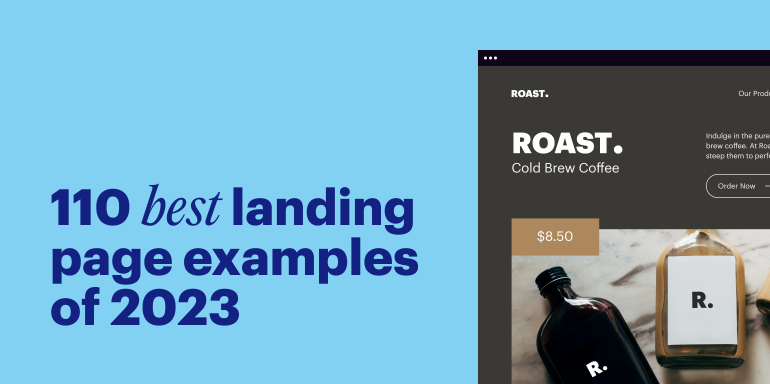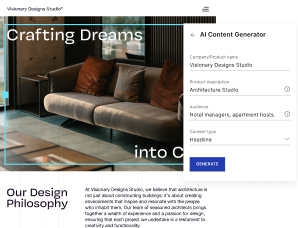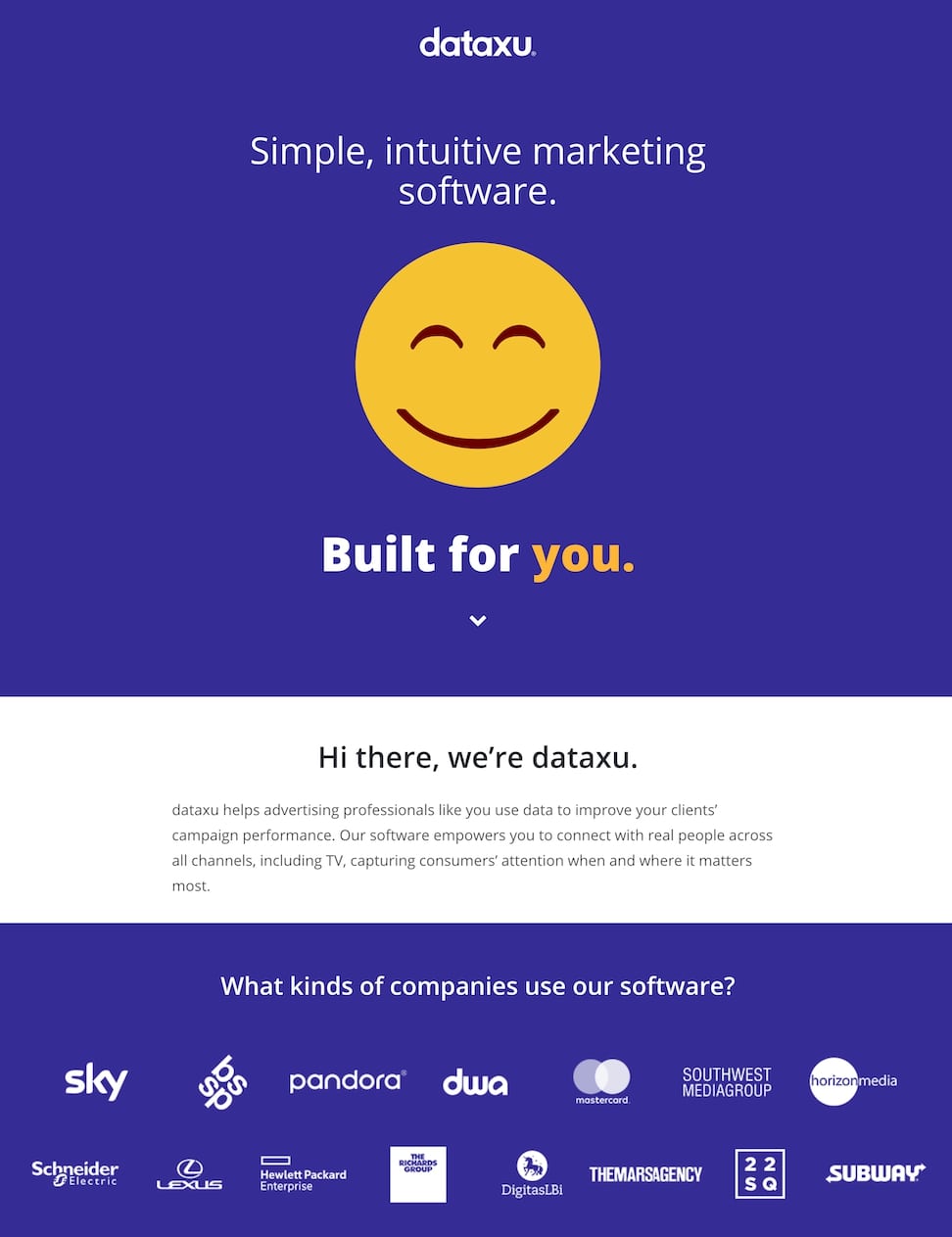When marketers sit down to create an effective marketing strategy, many of them take cues from industry leaders. We can do the same with landing page examples.
The action-oriented, standalone web pages are being used by businesses of all sizes to move people through every stage of the buyer’s journey. Before we delve into the 110 landing page examples, let’s first see what makes a landing page effective.
An effective landing page is a page that succeeds in converting visitors. High-converting landing pages use a combination of optimized and personalized elements, such as a benefit-driven headline, value proposition-focused copy, relevant media, social proof, and a conversion-worthy CTA offer to persuade visitors to opt-in. An ineffective landing page is a page that does the opposite. Remember, there is a significant difference between a homepage and a landing page.
Below you’ll find 100 examples of some of the best and worst landing pages on the internet, complete with full critiques. Sift through them to learn what to do and what not to do to create a highly effective landing page of your own.
(The landing page examples below were displayed as shown at one point in time. Some landing page examples have since changed but the critiques are still valid. Keep in mind, for shorter pages, we’ve shown the entire page. For longer pages, we only displayed above the fold.)
110 landing page examples
1. Casper
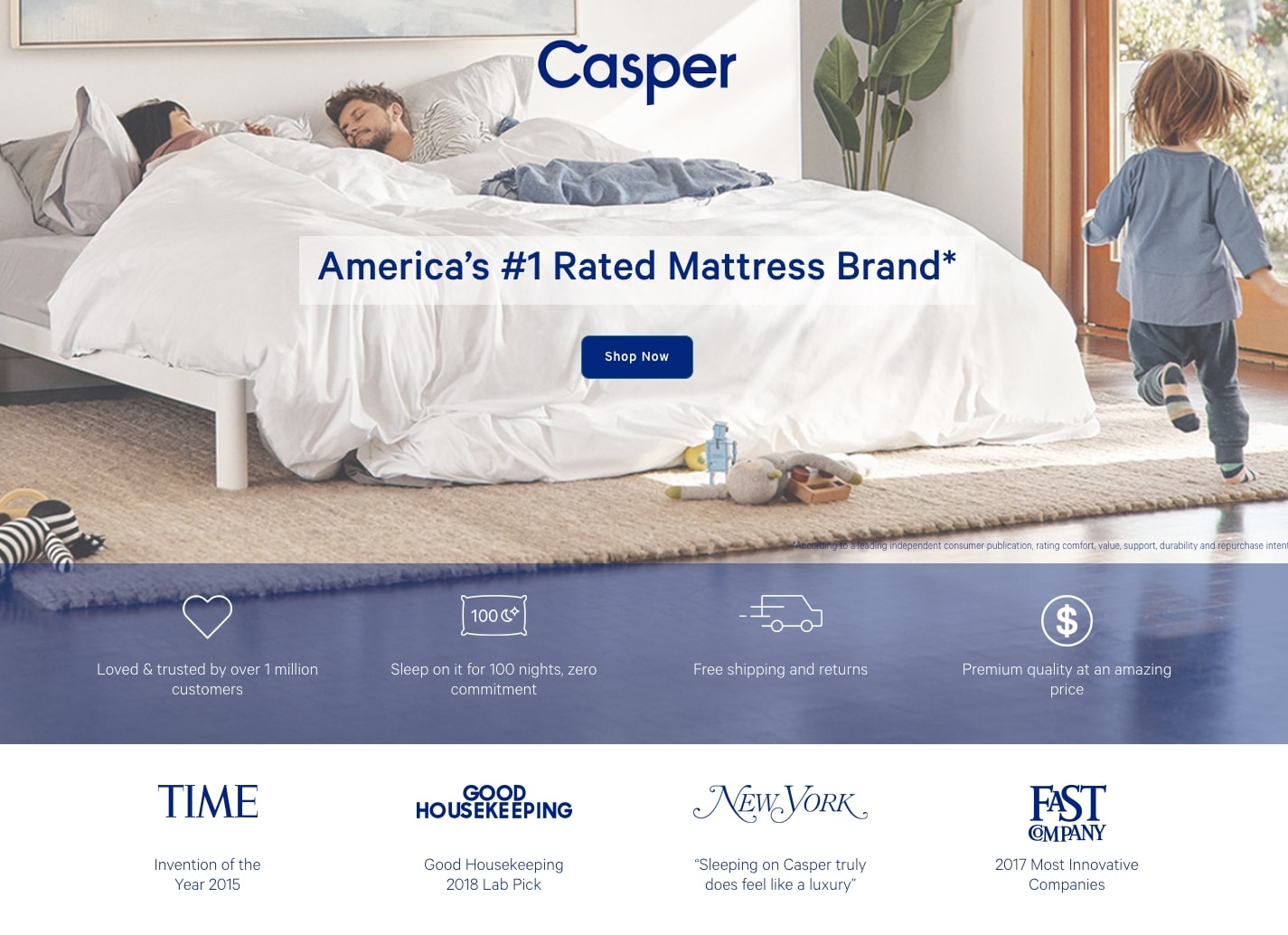
What they did well:
- The headline tells visitors why they should buy a Casper mattress.
- The imagery has a very homey, family feel which is perfect for the brand.
- The testimonials by influential brands such as Time & Good Housekeeping provide social proof for the offer.
- Bullet point copy makes it easy to read and lists the reasons why Casper is the smart choice for the visitor.
- The customer testimonials from regular people reassure the user that other people like them have also enjoyed sleeping on a Casper mattress.
- The 100-night risk-free offer adds credibility to the page.
- The pricing chart helps the visitor decide whether they should click the CTA button.
- The “Shop Now” CTA button contrasts with the background image and tells the visitor what to expect when they click it.
- The phone number option gives a chance to visitors to get all their questions answered.
What to A/B test:
- The secondary CTA button “Find a store near you” is great for visitors who aren’t ready to buy the mattress online without testing it out in person. However, having competing CTA buttons on the page means there are multiple goals. Not focusing attention on either one could limit conversions.
- Listing competing brands could backfire on Casper because even though they are listed as the least expensive option, consumers will likely research every other brand on the page, even if they were not aware of the other brands before seeing them listed here.
- With a rather long page, using anchor tags or visual cues could persuade visitors to pay attention to specific elements on the page (e.g. customer testimonials).
2. Merrill Edge
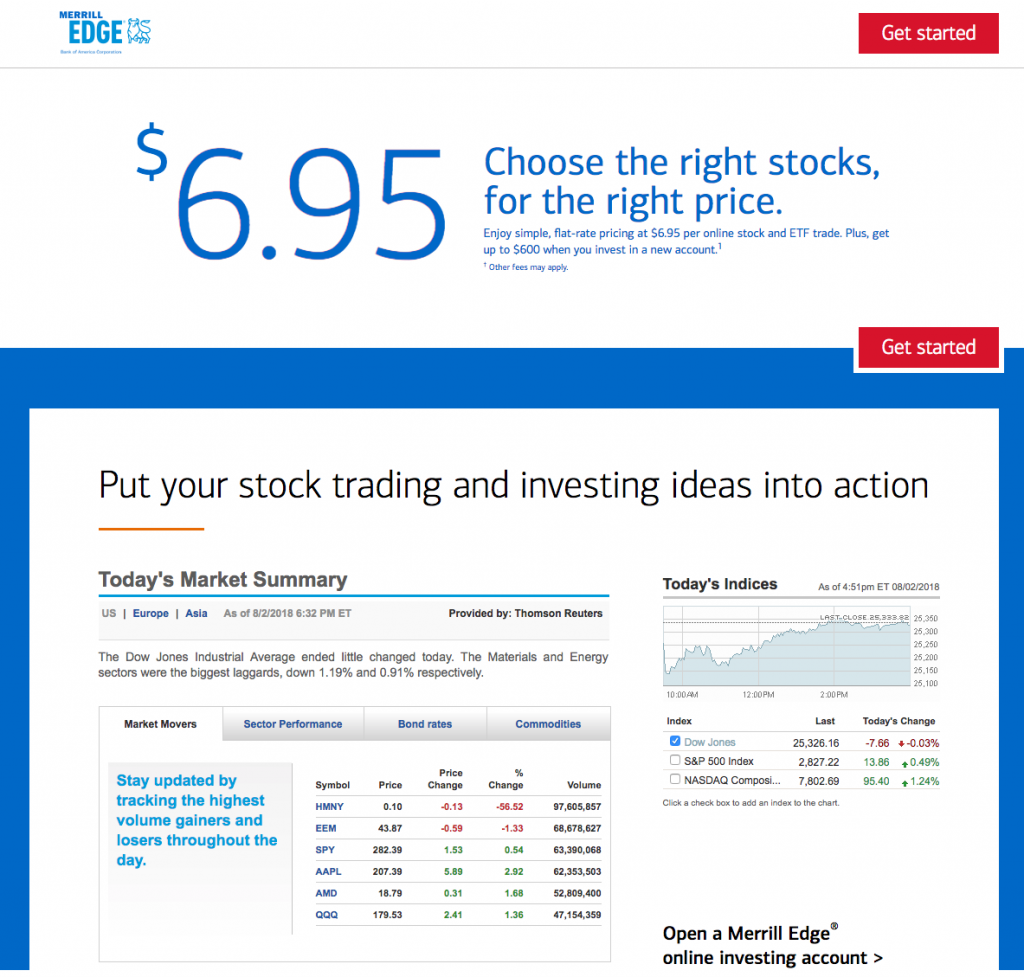
What they did well:
- The headline is clear because it explains why the visitor should do stock trading with Merrill Edge because it only costs $6.95 fee per online and ETF trade.
- The updated stock market summary image gives the visitor a recap of the market when they land on the page.
- The benefits are listed with iconography which helps the visitor read them quickly and understand the benefits of the offer.
- The account process is explained so the visitor knows what to do after they click the CTA button.
- The red CTA button color stands out on the page so you know exactly where to go to “Get Started” with Merrill Edge.
What to A/B test:
- The navigation links at the bottom of the page give the user an easy way to exit the page before clicking the CTA button.
- The “Get Started” CTA button copy could be improved because it is too generic. “Start Trading Now” provides more urgency and may encourage more conversions
- The verbosity of the page could be too much for the visitor to digest.
3. Magento
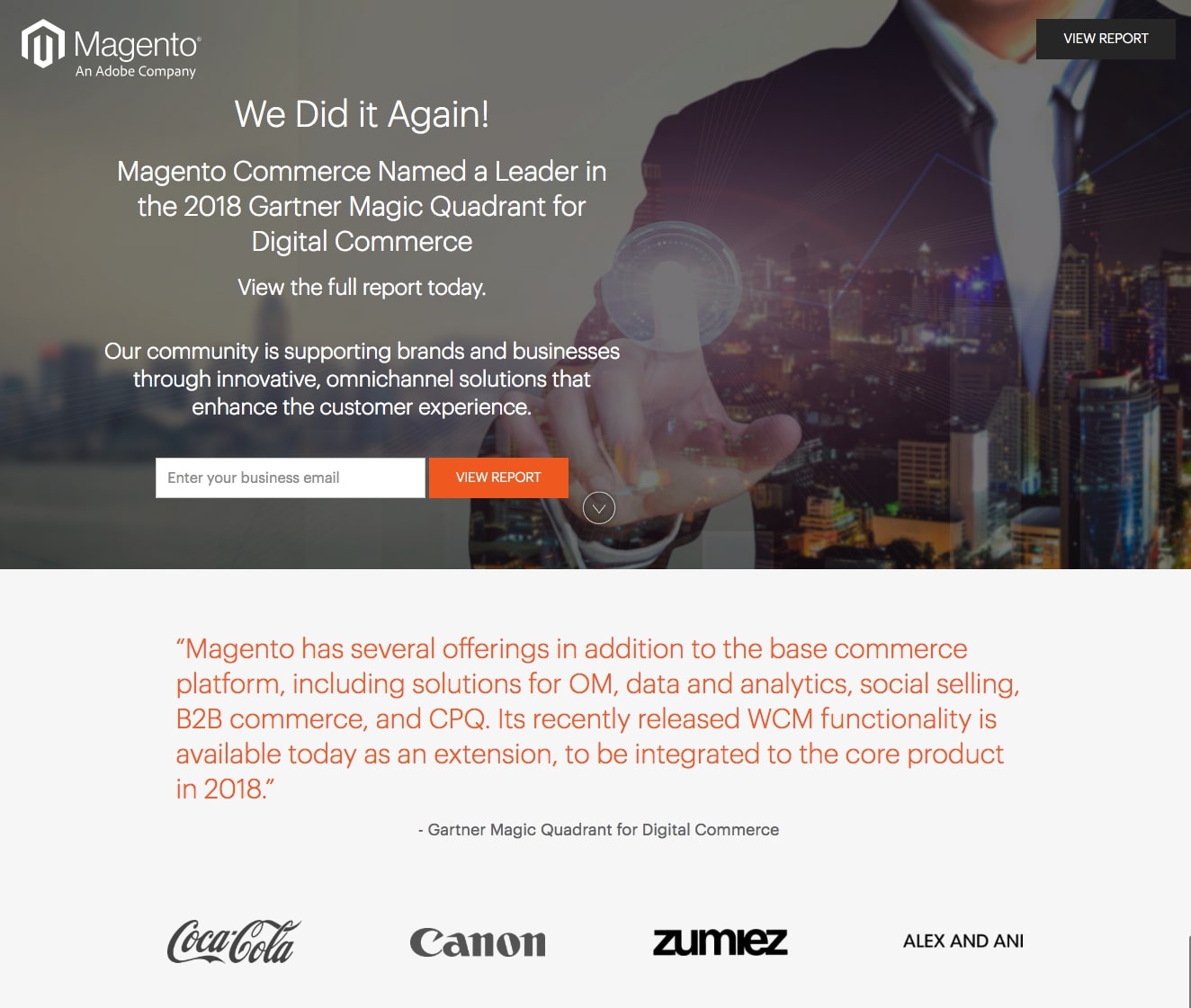
What they did well:
- The 1-field lead capture form is appropriate for a free report and likely generates a lot of conversions because visitors don’t have to give up too much personal information.
- The CTA button copy is relevant to the offer and the red button color contrasts with the page.
- Customer badges from Coca-Cola and Canon add social proof to the page.
- The Gartner quote gives the visitor a sneak peek of what the report will entail.
- The Magento by numbers section gives the user a quick snapshot of the company.
- Attractive iconography coupled with supporting copy details how the Magento platform works.
What to A/B test:
- The headline is unique but isn’t very persuasive. The supporting headline gives more details but it still speaks about Magento. Had it focused more on the visitor, it might generate more conversions.
- The featured image is a little confusing. How does a cityscape transposed onto a man’s body encourage people to download the report?
- The gray CTA button at the top right goes unnoticed because it doesn’t contrast with the gray background.
- Social media buttons near the bottom give people too many ways to leave the page without downloading the report first.
4. Quip
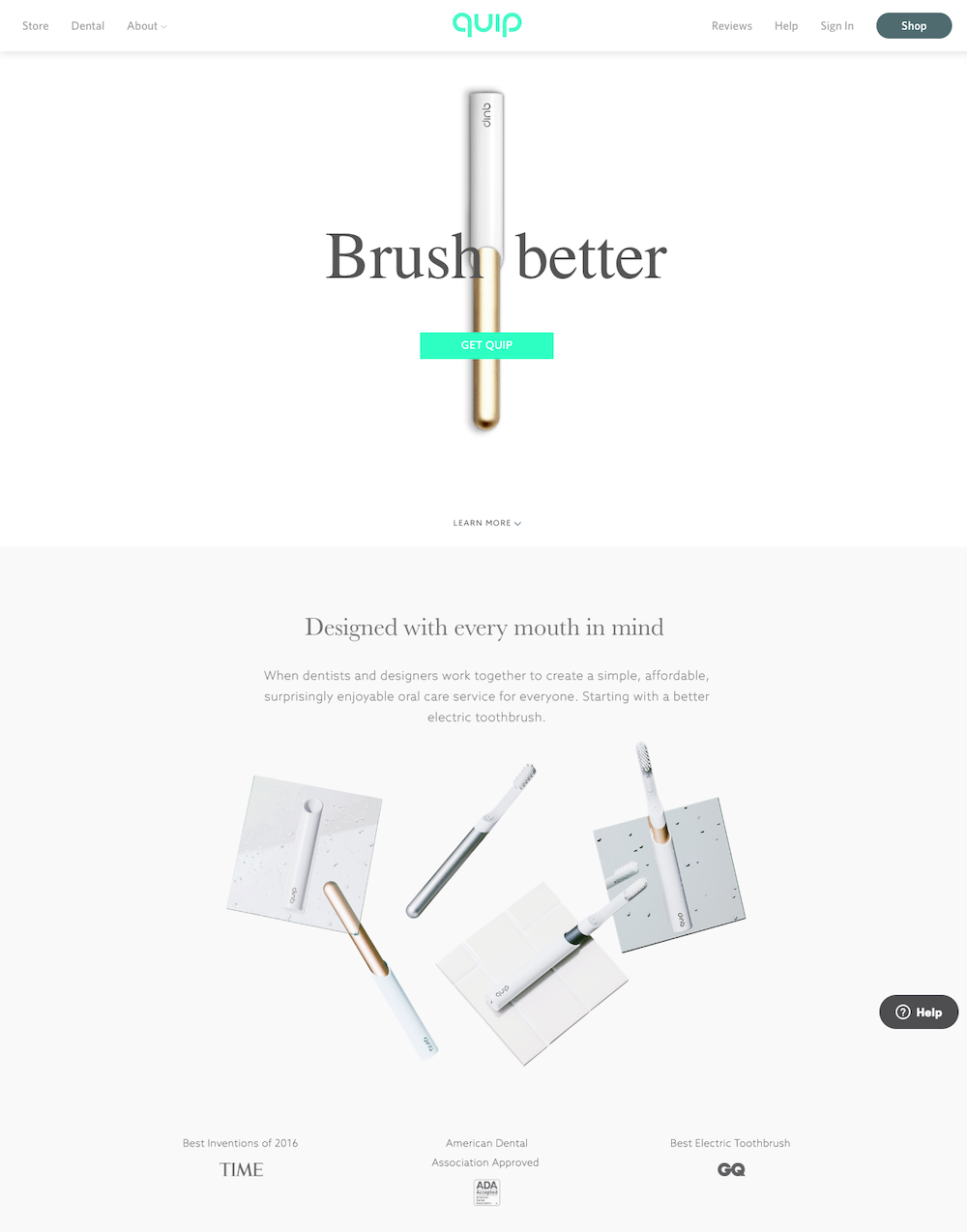
What they did well:
- The headline is clear and to the point because it states Quip’s UVP.
- The “Get Quip” CTA button copy is direct and lets people know that they will ‘Get Quip’ once they click it.
- The image of the different-sized brushes shows the visitor that Quip has a brush that’s perfect for their mouth.
- The big brand reviews by GQ, Time, and American Dental Association add credibility to the offer.
- Quip’s benefits are mentioned in separate page sections with relevant images that add a nice visual appeal to the page while explaining each benefit.
- The pricing section allows people to choose which Quip model to purchase.
- The FAQ section answers the most common inquiries Quip receives so the visitor can make an easier decision.
What to A/B test:
- The navigation links in the page header give the user a way to leave the page very quickly. What is the goal of this page: for people to navigate around, or to generate new customers?
- The 4.96 rating is impressive, but without mentioning where the reviews are hosted, prospects may question if the reviews are real and where they can read them.
- The blog links on the page don’t make a lot of sense because they take the visitor away from the offer.
- The light green CTA buttons don’t contrast with the page as much as they could. By designing them the same color as the blog images at the bottom, they may not receive as many clicks.
5. Glen Park
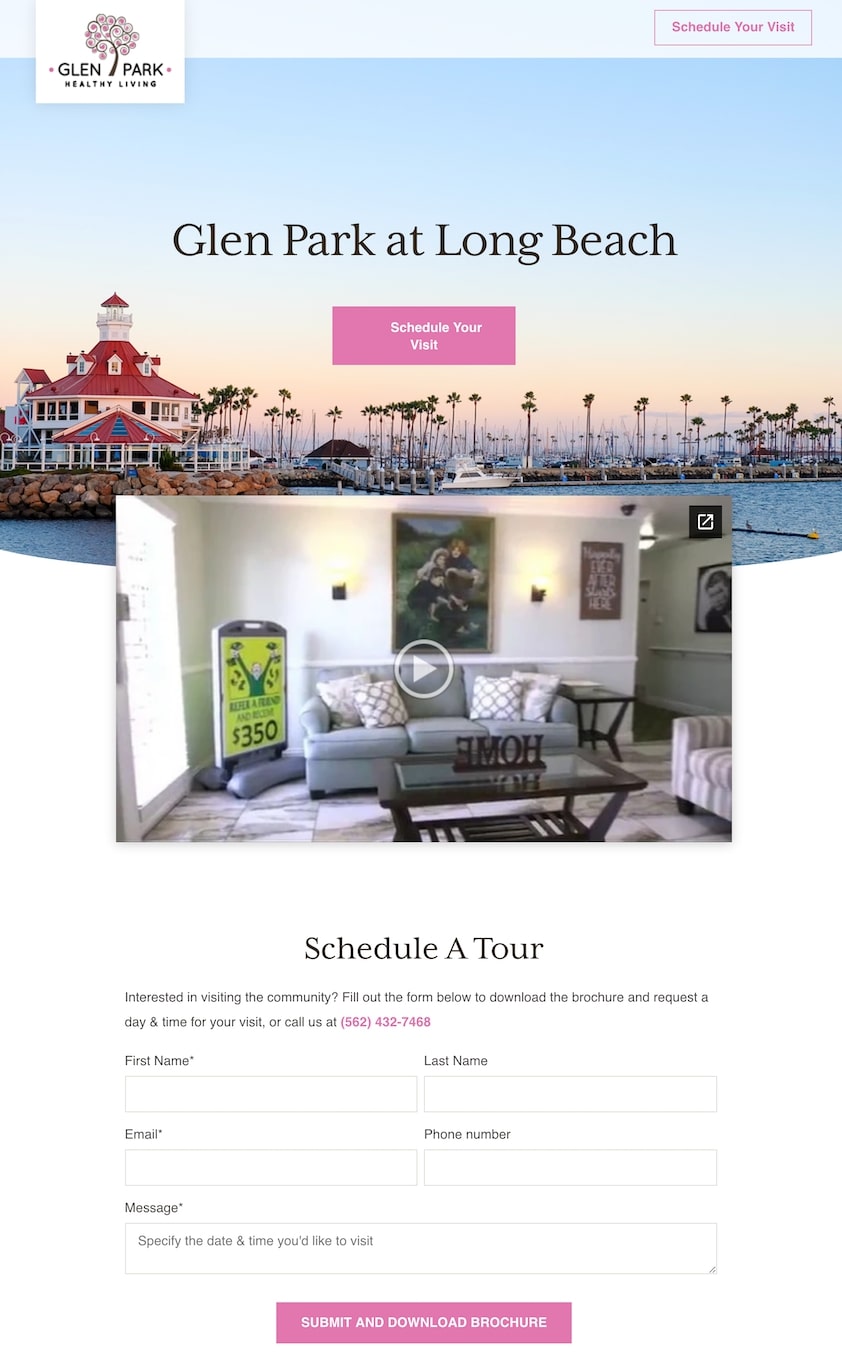
What they did well:
- The services are explained with bullet points which makes it easier for the user to review them and decide whether Glen Park is the best option for the visitor.
- The accreditations add credibility to the brand.
- The floor plan images help the visitor get a better visual feel for the facility.
What to A/B test:
- The headline is pretty bland and doesn’t convey the USP of the Glen Park facility. Instead, the headline could use an emotional narrative that would speak to the visitor’s emotional side.
- The CTA button copy seems to be misaligned, making the button look odd.
- The first schedule a tour section comes a bit too early on the page. The visitor has not had a chance to review the accreditations, services, social activities, types of care offered, or floor plans yet further down the page.
- The form requests too much information just to download a brochure.
6. Capella University
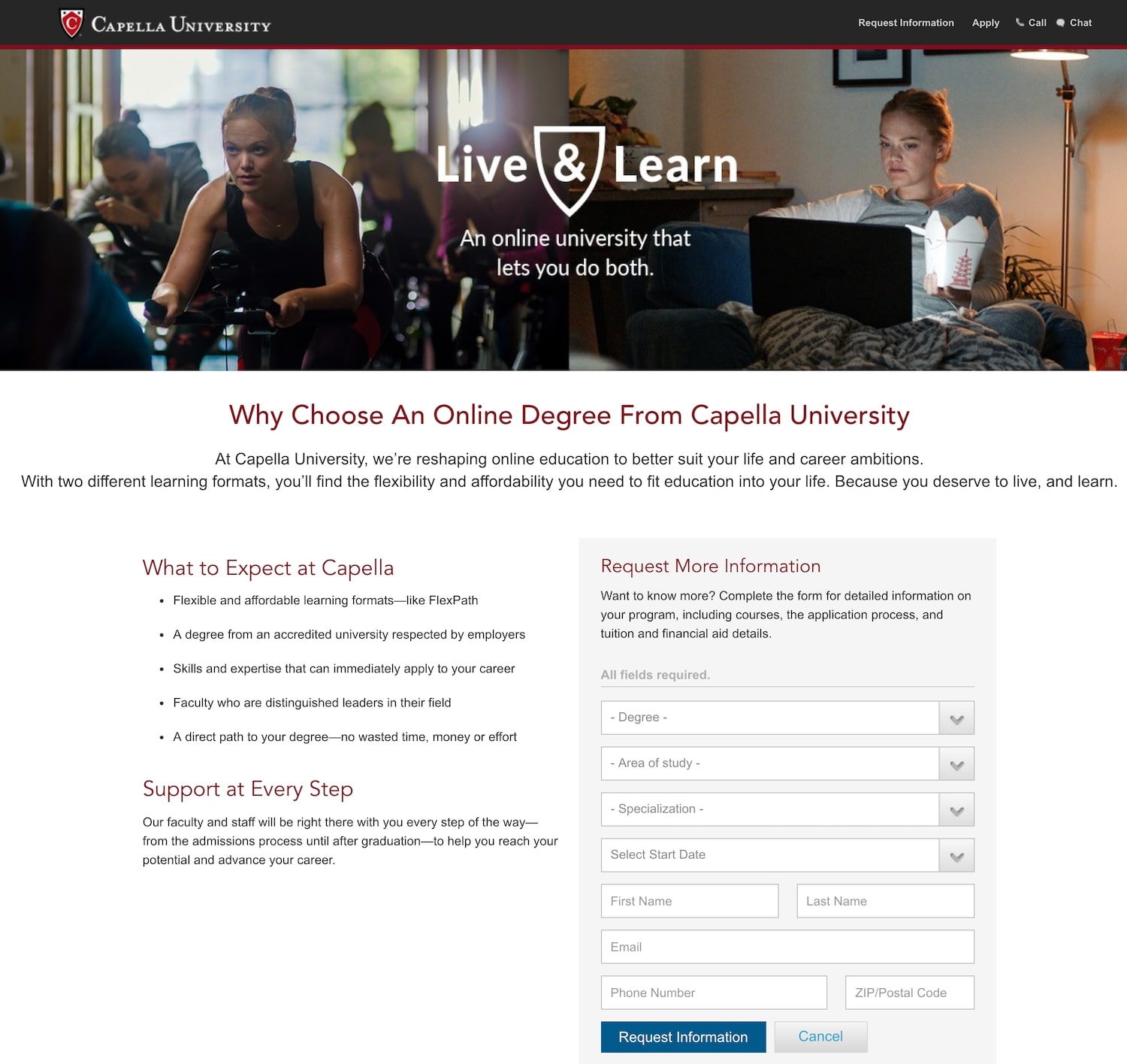
What they did well:
- The headline will resonate with the visitor since it addresses a problem that most college students experience.
- The background image is very relevant to the headline.
- The bullet points list why the visitor should enroll in Capella University.
- The form headline and the CTA button copy maintain message-match.
- The accreditation section ensures the visitor that the university is a recognized facility for higher education.
What to A/B test:
- The navigation links in the page header and footer give visitors a way to exit the page.
- The empty space to the left of the form makes the page seem unbalanced. In addition, letting elements breathe more between the form and copy lets people scan the page and understand each section better.
7. Guideline
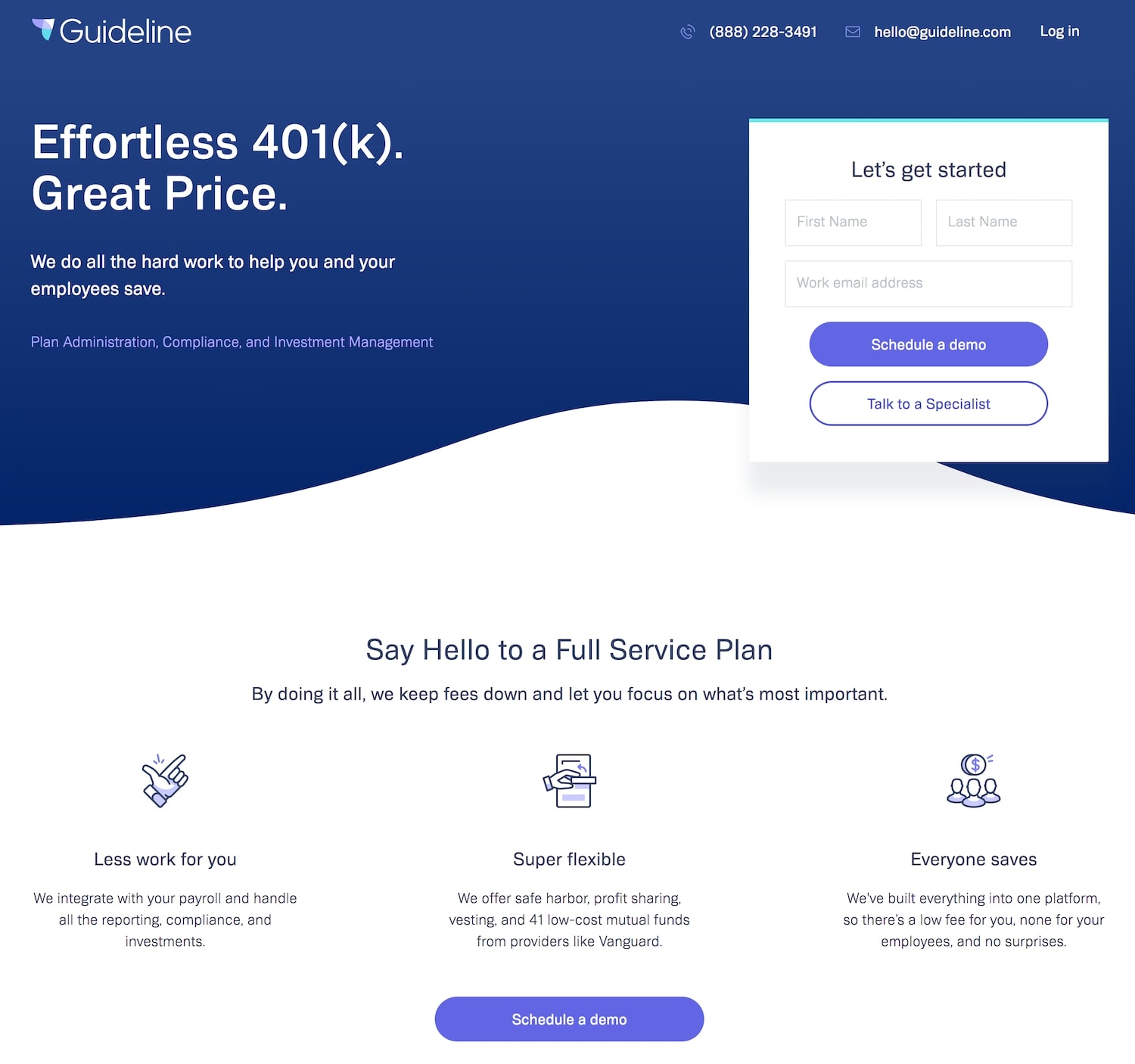
What they did well:
- The headline highlights the service’s UVP.
- The form is short and doesn’t ask for unnecessary information.
- The primary and secondary CTA button both have clear copy.
- Ample white space throughout the page makes the page aesthetically pleasing and likely won’t create anxiety for prospects.
- Bullet point benefits make it easier for the visitor to take in all the information and understand the Guideline 401K program.
- Social proof from The New York Times, CNBC, Forbes, and others add credibility to the page.
What to A/B test:
- The headline can be more descriptive. Even though it highlights the UVP, adding more detail would make the headline more convincing.
- Adding customer testimonials would help visitors make their decision, as they would allow the visitor to see how others have benefitted from Guideline.
8. Munchery

What they did well:
- The headline explains the services: fresh food delivered to you without you leaving the house.
- The background image is mouthwatering and relevant to the offer.
- Nearly 900 Trustpilot customer reviews help the visitor decide whether they should order from Munchery.
- The customer favorites section gives visitors a peek of what kind of meals they can expect from Munchery.
- The $20 off badge encourages visitors to take action and order food.
- The multi-step form helps visitors complete the sign-up process.
What to A/B test:
- The $20 off coupon could get more attention in the headline this way the visitor is likely to notice it as soon as they arrive on the page. Of course, this could also encourage more new users to try Munchery.
9. Cruise Zap
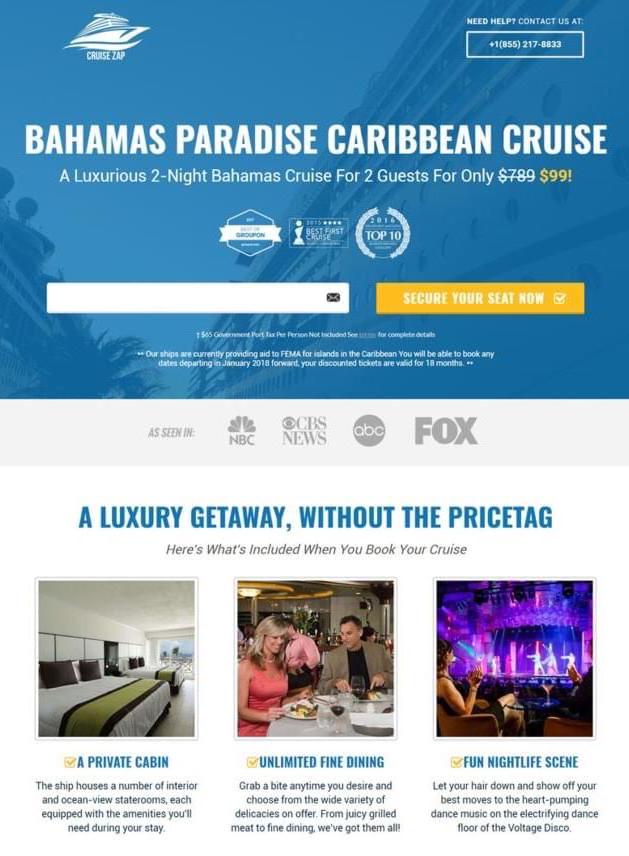
What they did well:
- The price strike-through in the headline reinforces the idea that the offer is available for a significant discount.
- The yellow CTA button jumps off the page and encourages visitors to start securing their cruise reservations now.
- The CTA button copy addresses the visitor in the second-person tone of voice and is relevant to the offer.
- The “As Seen In” section features notable brands such as NBC, CBS News, and FOX which reassures the visitor that Cruise Zap is a legitimate brand.
- The video testimonials are convincing because they feature real people who took advantage of the special offer. Plus, they are very short so visitors don’t have to sit through long videos to hear the customer stories.
- The FAQ section helps the visitor decide whether they want to invest in Cruise Zap.
What to A/B test:
- The headline could include an attraction of the cruise to make it more persuasive.
- The images look like bad stock photos and pretty boring for cruise pictures.
- More white space from top to bottom could help people navigate the page more efficiently.
10. dataxu

What they did well:
- The headline explains what dataxu does.
- The customer badges show prospects some of the big-name brands who have already benefited from dataxu.
- The 2-minute video is short and lets people know how long the content is before they hit play. Once clicked, the video shows visitors how customers can use the software.
- The security seals tell visitors it’s safe to use the software.
What to A/B test:
- The 97% fraud-free investment declaration could go against the offer, maybe the missing 3% is more important to visitors than the 97%.
- The report offer on the landing page gives visitors a way to leave the page.
- The ‘Learn More’ CTA button copy underneath the demo video could be more explicit about what happens next.
- Adding more white space would space everything out better and allow prospects to consume the page content better as they evaluate dataxu.
11. Uber
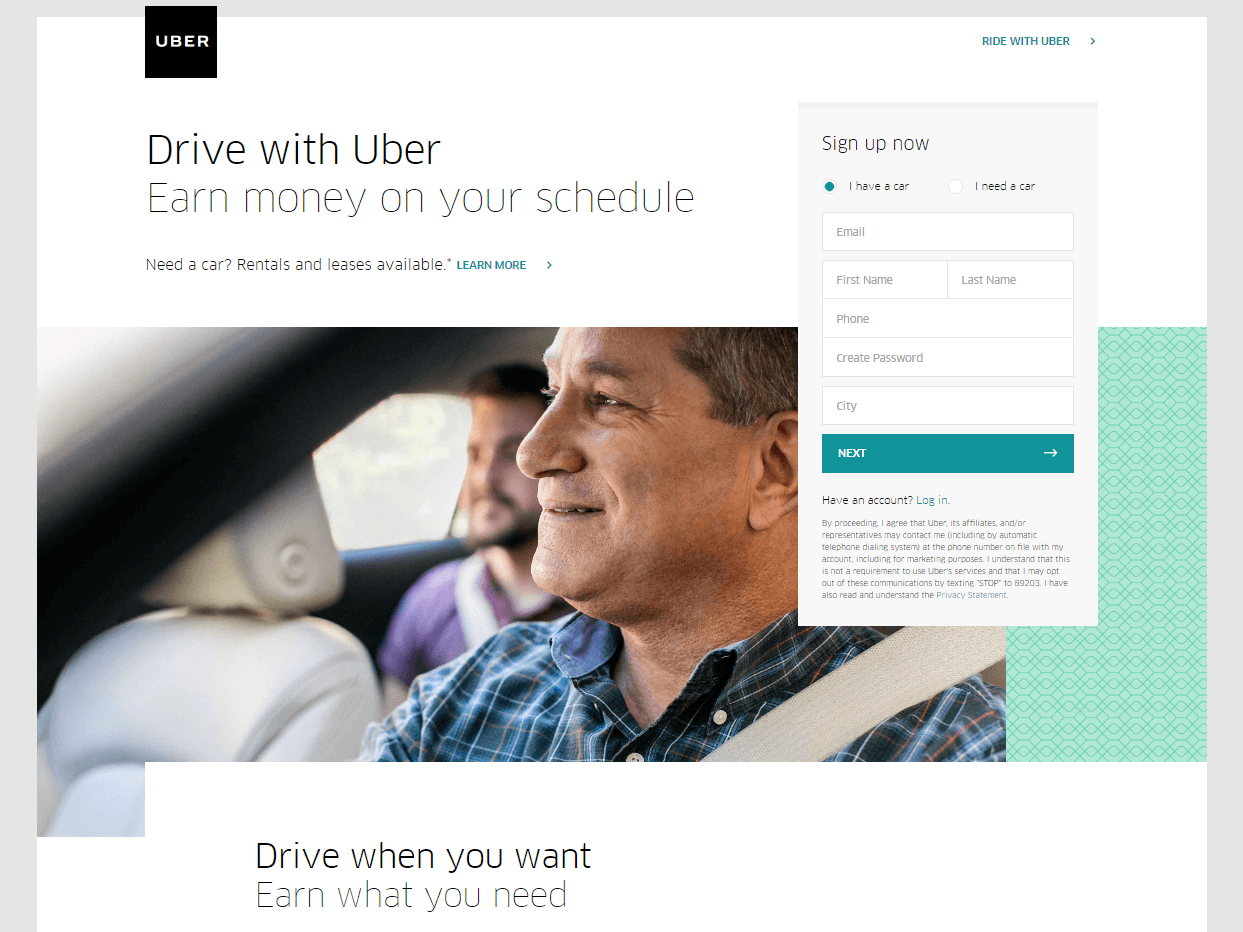
What they did well:
- The headline communicates a clear benefit.
- A short form makes converting on this page easy.
What to A/B test:
- The "Ride with Uber" link is unnecessary. All it will do is drive prospects off the page. If they wanted to ride with uber, they would’ve clicked a PPC ad that allowed them to ride with Uber.
12. Moz
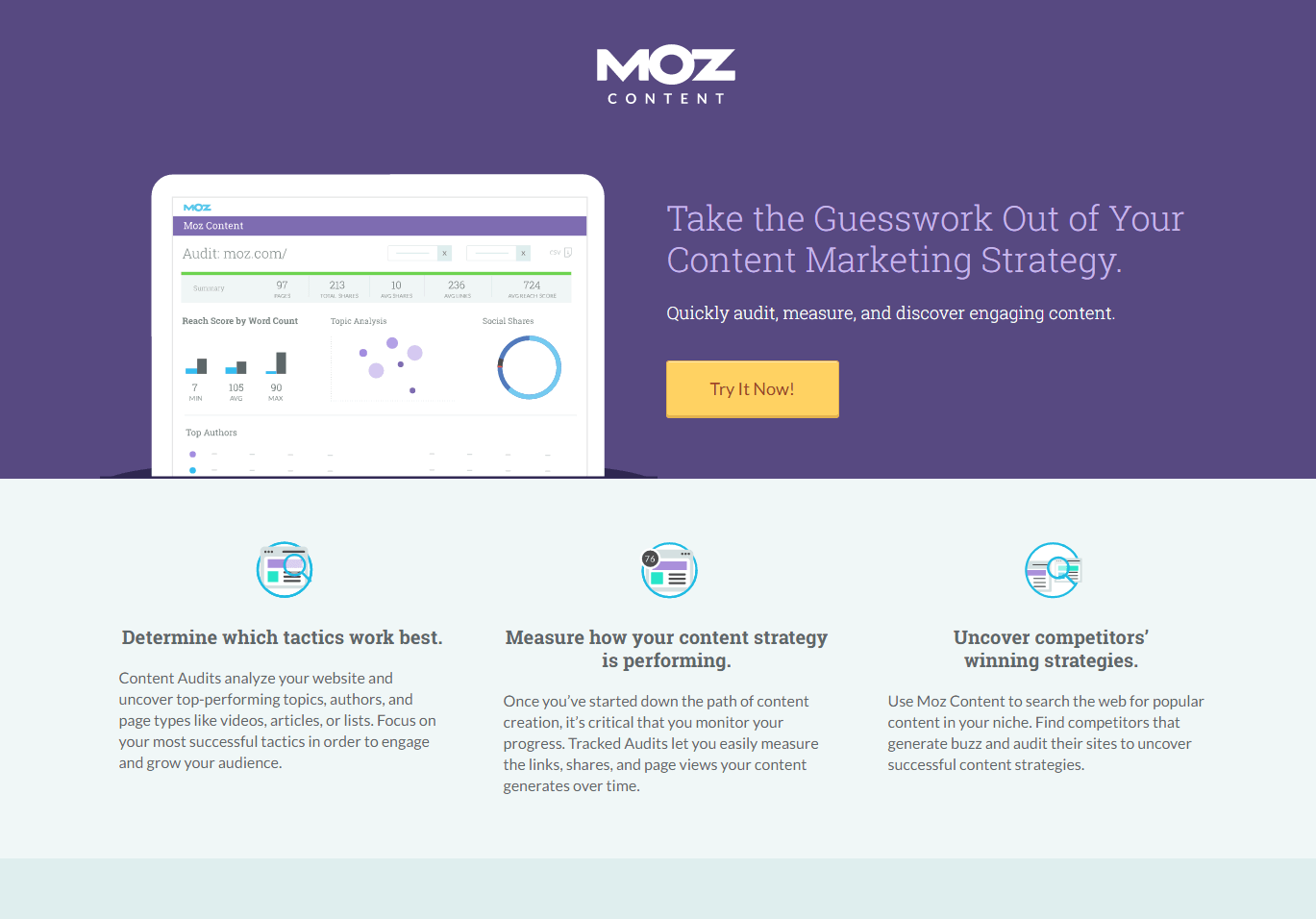
What they did well:
- The headline and subheadline work together to form a strong value proposition.
- The CTA button color draws prospect's attention.
- The image gives an inside look into what using the product is actually like.
- The copy is optimized for readability in small chunks.
- A minimalistic footer doesn’t distract prospects from converting with links to other pages or social accounts.
- Social proof at the bottom of the page boosts prospect trust.
What to A/B test:
- A hyperlinked logo allows prospects to escape to the homepage without converting.
13. HubSpot + Canva
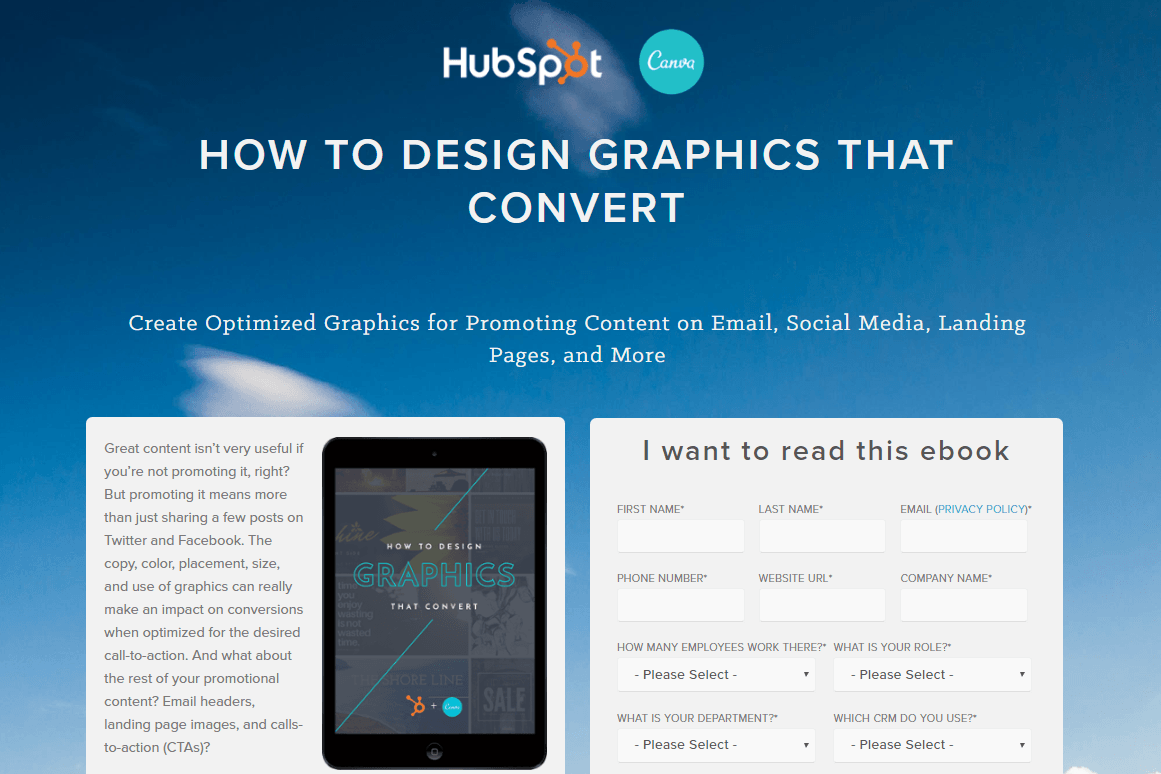
What they did well:
- The “How To” headline communicates a clear benefit.
- Copy separated into chunks make for an easily digestible page.
- The image serves as a visual representation of the offer, showing visitors what they’ll get after converting.
What to A/B test:
- This long form might deter prospects on the page from converting.
- The background image is confusing considering the ebook is about graphics. What does a mountain range have to do with graphics?
- More white space could help let the page elements “breathe” more and be even more persuasive than their current placement.
14. Content Marketing Institute

What they did well:
- The headline communicates a clear benefit.
- Bulleted copy quickly communicates the benefits of the offer.
- The ability to select a webcast lets visitors choose the more appropriate content for their needs.
What to A/B test:
- This CTA button is easy to miss.
- Text blocks to the right make this page an intimidating one to read.
- The 9-field form might scare visitors off this page.
- The Twitter “share” button allows prospects to escape the page. What if your visitor shared the page, but didn’t return to the page and register themselves?
15. LinkedIn
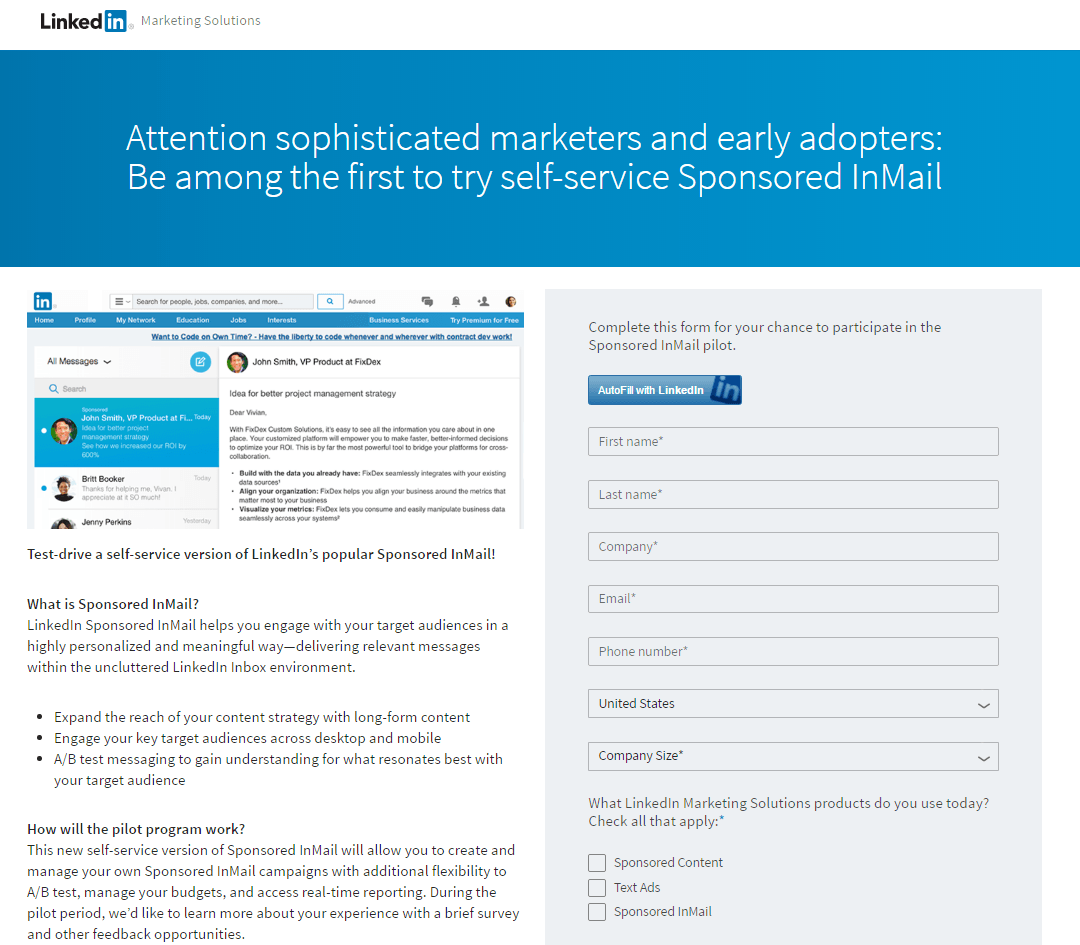
What they did well:
- Bulleted copy quickly communicates the benefits of the offer.
- The image gives an inside look into what using the product is actually like.
- Text is separated into smaller, readable chunks.
- The “autofill with LinkedIn” button allows visitors to complete the form with a simple click instead of having to complete this lengthy form.
What to A/B test:
- “Submit” is as lazy and unremarkable as CTAs get.
- Numerous outbound links, including the LinkedIn logo and social media buttons, provide way too many options for visitors to abandon the page without converting first.
- The headline doesn’t convey a clear benefit. It also uses jargon, who exactly are “sophisticated marketers?”
16. Forrester Research

What they did well:
- CTA button color contrasts with the white background, making the button more visible to visitors.
- Image of the report is relevant to the offer, and gives visitors a sneak peek into what the report will entail. However, the image could be larger.
What to A/B test:
- The hyperlinked logo gives visitors a chance to exit the page without downloading the report.
- The form is too long for a free report landing page. Plus, all form fields are required, which adds friction to the page.
- The copy is written from the company’s perspective, using the pronoun ‘our’. The copy should be replaced with customer-centric copy describing why the report is beneficial for visitors.
17. Microsoft

What they did well:
- The copy is benefit-oriented, and separated into bite-size chunks for easy reading.
- Bullet points offer a skimmable preview of the content of the ebook.
- Text above the form lets the visitor know exactly what they need to do to convert.
What to A/B test:
- This logo, linked to the homepage, has the potential to draw users away from the page before they have a chance to click its CTA button.
- The headline, “Intelligent Security: Using Machine Learning to Help Detect Advanced Cyber Attacks,” doesn’t communicate a clear benefit. It could, though, with the words “How To” preceding it. “Intelligent Security: How To Use…”
- This CTA button color could be changed to call more attention.
- Vanishing gray labels within form fields have the potential to annoy and confuse prospects, research shows.
18. GEICO

What they did well:
- A non-hyperlinked logo won’t allow visitors to leave the page.
- An extremely short, one-field form only asks for zip code and collects more information later in the process.
- The CTA button copy is tailored to the offer.
- A minimalistic footer doesn’t distract prospects from converting with links to other pages or social accounts.
What to A/B test:
- The headline “See how much brighter your day could get,” doesn’t convey a tangible benefit. However, we all know GEICO well enough to know their tagline “15 minutes could save you 15% or more on car insurance,” to the point that branding fills in the gaps for us.
19. PayPal

What they did well:
- The word “Free” emphasizes the no-cost nature of the offer.
- A blue CTA button pops off the page.
- Bulleted copy quickly communicates the benefits of the offer.
- The image serves as a visual representation of the offer, showing visitors what they’ll get after converting.
- A minimalistic footer doesn’t distract prospects from converting with links to other pages or social accounts.
What to A/B test:
- The CTA “Download Now” isn’t as tailored to the offer as it could be.
- The image text isn’t readable.
- The logo is linked to the homepage, allowing prospects to leave the landing page without converting.
20. Jeff Bullas

What they did well:
- The headline and subheadline communicate a clear benefit.
- The CTA button color draws prospects' attention.
- The image serves as a visual representation of the offer, showing visitors what they’ll get after converting.
What to A/B test:
- The testimonial is from Jeff Bullas, and not one of his satisfied customers. Testimonials are great, but this one comes across as self-promotional. If the quote was from a marketing influencer who used Jeff’s blogging secrets to improve their own campaigns, the testimonial would add even more value.
21. Alexa
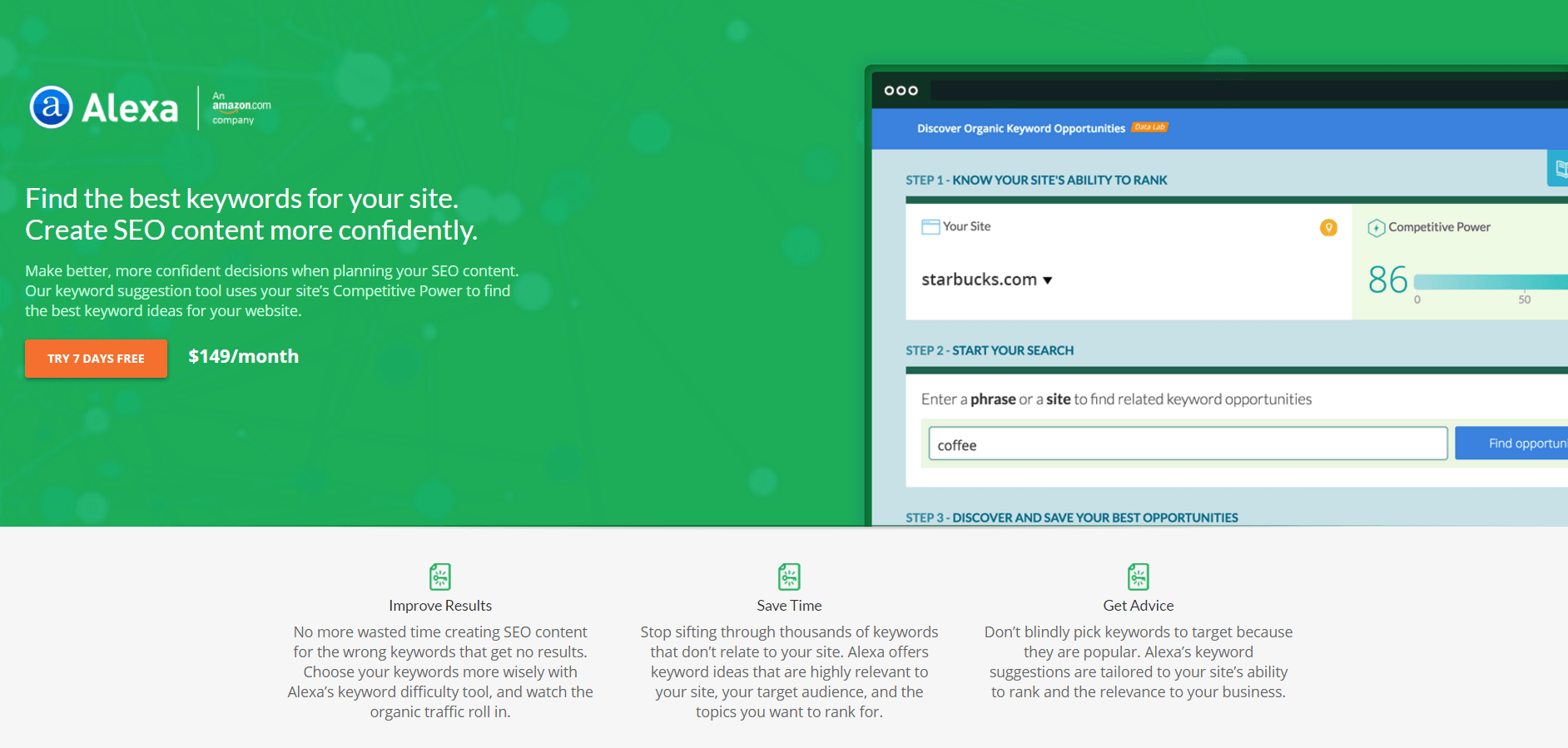
What they did well:
- The headline communicates a clear benefit.
- The CTA button color draws prospects' attention.
- The copy is separated into digestible chunks for easy reading.
- A non-hyperlinked logo doesn’t allow prospects to escape the page through it.
- Three cooperative CTAs work together to convert prospects in different locations on the page.
- The Amazon logo aligns Alexa with a powerful, well-known brand.
- Features of the product are emphasized, which is usually a no-no, but so are their respective benefits.
- A minimalistic footer doesn’t distract prospects from converting with links to other pages or social accounts.
- The text “Get started in less than 10 minutes” emphasizes an instant solution, which we as an impatient collective are all drawn to.
What to A/B test:
- More white space would allow each landing page element to “breathe” more and draw even more attention to the CTA.
22. HubSpot
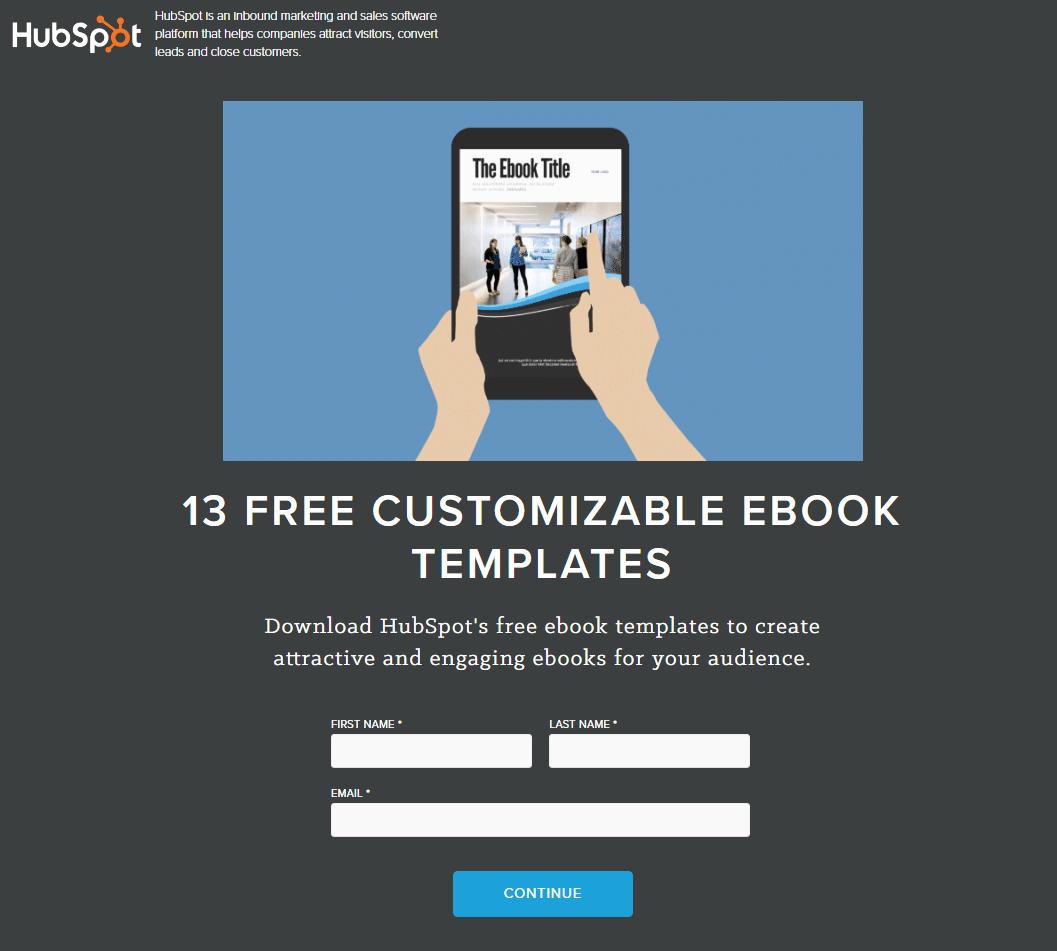
What they did well:
- Short paragraphs and bulleted copy make this page easy to get through.
- The CTA button color attracts prospects' attention.
- Multiple CTAs work together to convince prospects to convert.
- The image serves as a visual representation of the offer, showing visitors what they’ll get after converting.
What to A/B test:
- The CTA “Continue” could be more compelling.
- The social media buttons give people an exit point on the landing page.
23. Microsoft
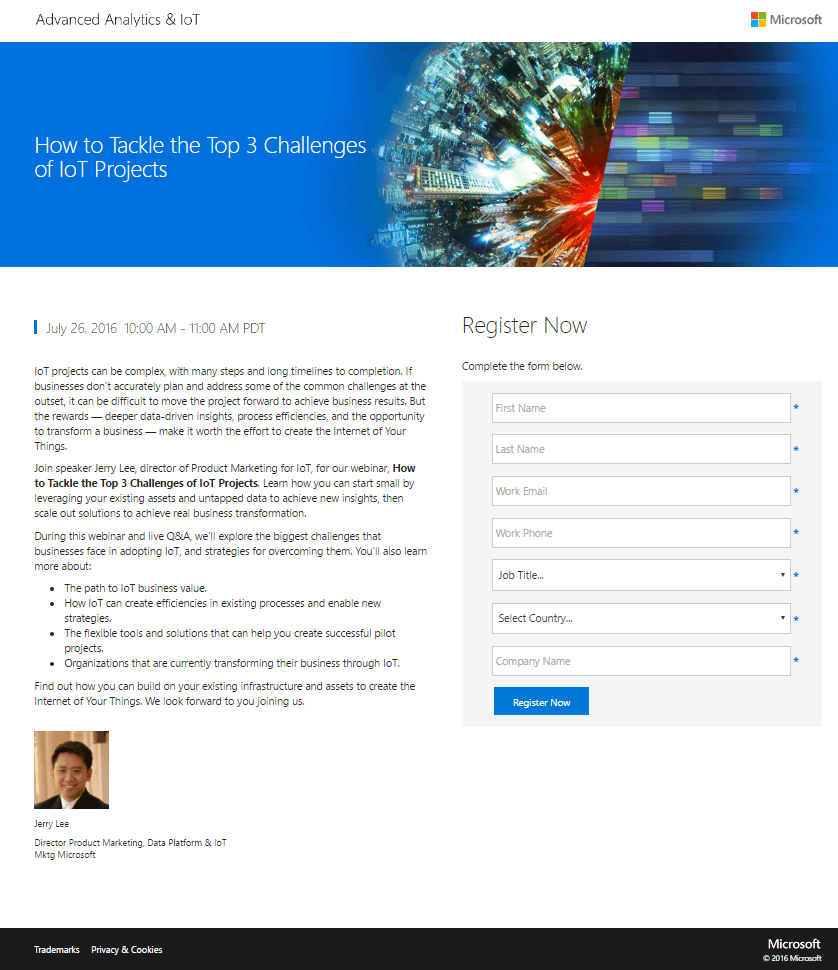
What they did well:
- The headline communicates a clear benefit.
- Bulleted copy quickly communicates the benefits of the offer.
- The word “Now” in the CTA takes advantage of our desire for instant gratification.
What to A/B test:
- The verbosity of this page could be reduced.
- The CTA button copy could be personalized to match the offer.
24. WordStream
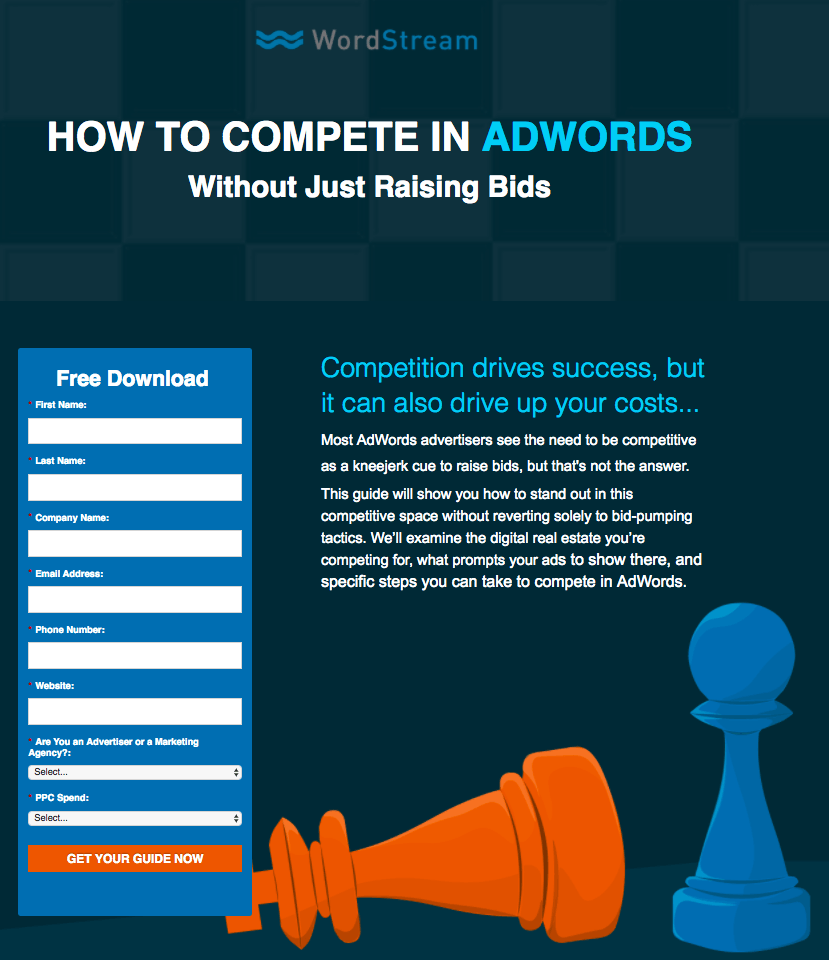
What they did well:
- The headline is creative, potentially offering a little-known secret solution different from the norm.
- The fallen chess piece serves as a visual aid, pointing toward the CTA button.
- The CTA button color draws prospects' attention.
- The copy teases the content of the guide.
- The word “free” capitalizes on our desire to get something for nothing.
What to A/B test:
- Social media links in the footer can potentially drive prospects off the page before they can convert.
- The form color is the same color as the headline and a portion of the copy. It doesn’t stand out as much as it could from the rest of the page.
25. Sujan Patel

What they did well:
- The CTA is written in first person.
- A testimonial from a happy customer strengthens the credibility of this offer.
- The “name a fair price” field lets people select how much they want to pay. We would be curious to find the data on what dollar amounts visitors have agreed to pay Sujan Patel...
What to A/B test:
- The image doesn’t add anything to the offer.
- The language select field is great but it only translates the email and navigation links, the name your price field, and the CTA copy. If you can’t read English, how else are you supposed to be persuaded by the testimonial and ultimately purchase the ebook?
26. Hired

What they did well:
- The headline “Reach 4,000 Companies At Once” conveys a clear benefit.
- The green CTA button pops on the white form.
- Bulleted copy quickly communicates the benefits of the offer.
- A short form makes signing up easy.
- The “Free” nature of the service is emphasized in the subheadline.
- The salary range noted in the subheadline is above average, even on the low end.
What to A/B test:
- A navigation menu and a hyperlinked logo let prospects leave the page way too easily.
27. Birst

What this page does well:
- The first line of text relates to the page’s visitors by asking them a question they’ll likely answer “yes” to.
- Bulleted copy gives visitors an idea of what they’ll learn by reading the report.
- The CTA button color stands out against a white background.
- The word “now” in the CTA takes advantage of visitors’ desire for instant gratification. If you click the button, you get to read the report immediately.
What to A/B test:
- The headline here could be stronger. Birst misses the opportunity to use an authoritative company’s praise as a social proof headline. “See Why Gartner Rated Birst As One Of The Best BI Platforms On The Market.” Remember -- you can describe your product as the “best” if someone else said it about you, but you can’t say it about yourself.
- The fine print here should go. If you actually take the time to read it, you realize that there’s nothing fishy going on here. But the problem is, not everyone will. They’ll see fine print and assume there’s a catch to this. Leave it italicized and make it bigger so visitors can read it. Birst has nothing to hide here.
- Light-gray labels within each form field have the potential to frustrate visitors when they disappear.
28. Domo
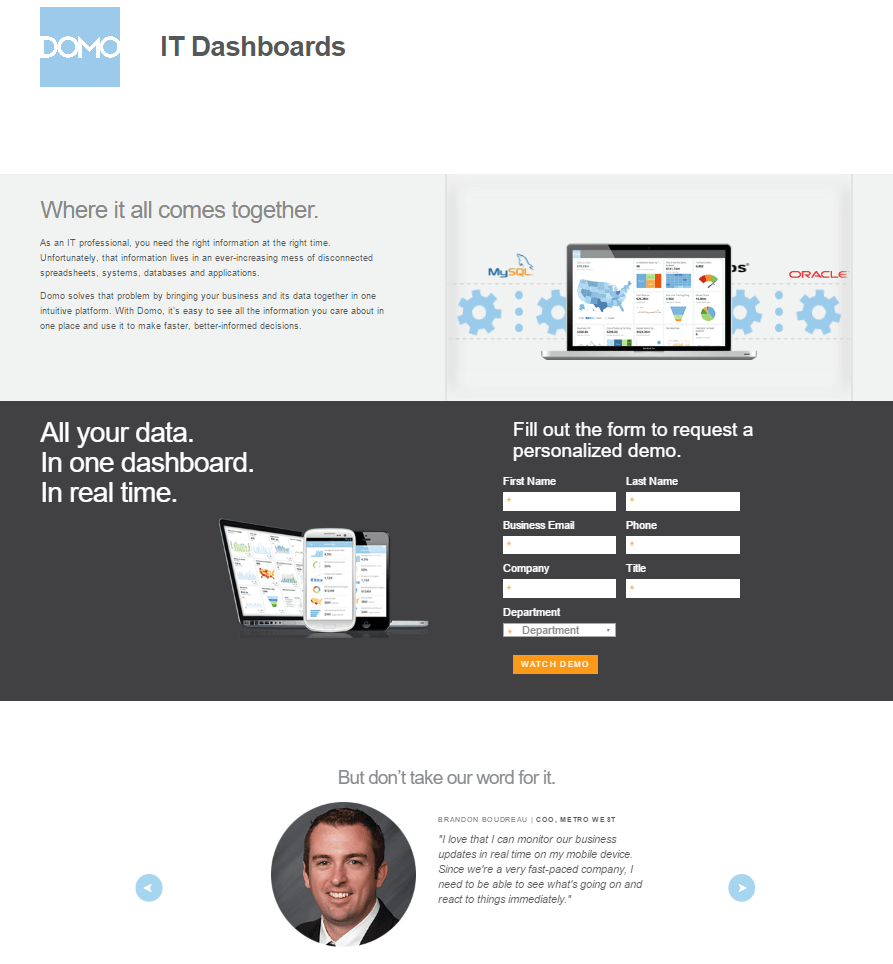
What they did well:
- Testimonials from happy customers serve as social proof.
- The CTA button color pops off the page.
- The CTA button color draws prospects' attention.
- A minimalistic footer doesn’t distract prospects from converting with links to other pages or social accounts.
What to A/B test:
- The headline doesn't convey a clear benefit at all.
- The CTA button could be much bigger to draw more attention as the most important element on the page.
29. Salesforce

What they did well:
- The headline communicates a clear benefit.
- Minimal text makes this page a breeze to get through.
- The image serves as a visual representation of the offer, showing visitors what they’ll get after converting.
- Security badges let prospects know their information is safe.
- The word “Now” in the CTA capitalizes on our desire for instant gratification.
What to A/B test:
- This CTA is really easy to miss, as it’s only a slightly different shade as the form it’s on.
- A busy footer, complete with a sitemap and social buttons, allows prospects to leave the page without converting.
- The CTA button copy should be changed to something more personalized.
30. Indeed Crowd
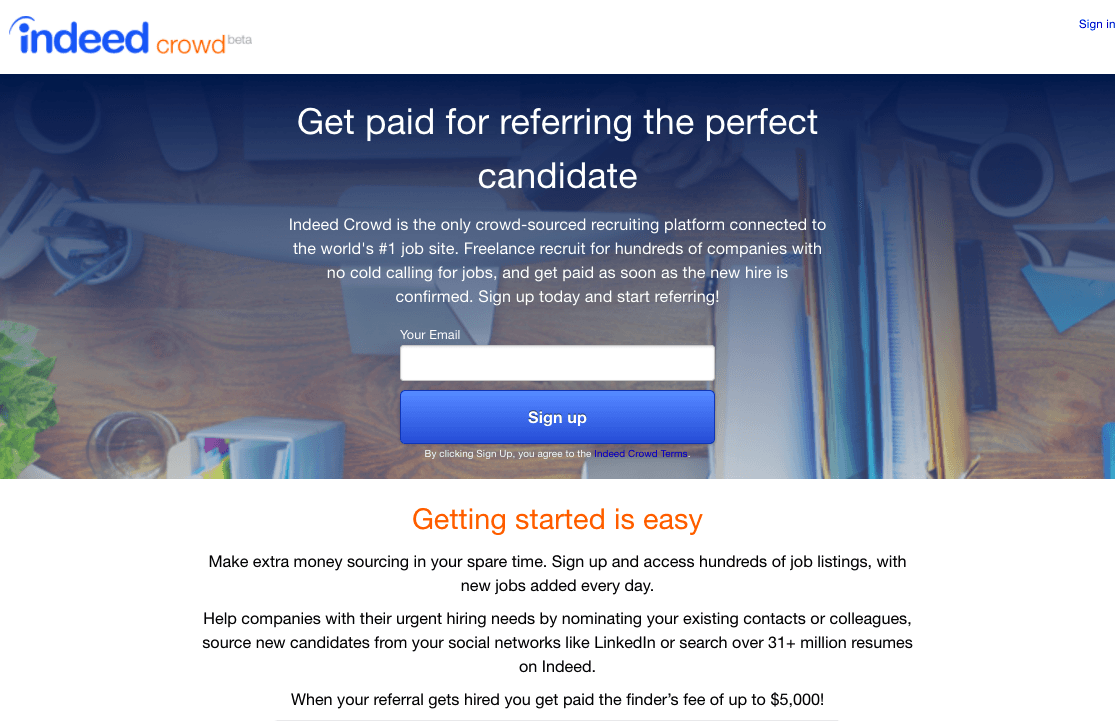
What they did well:
- The headline conveys a clear benefit to the visitor: get paid for referring a candidate that gets hired.
- Minimal, skimmable text makes getting through this page easy.
- Cooperative calls to action work together to convert the visitor.
- The copy emphasizes flexibility and ease of use. Registrants can make extra money whenever they want.
- A screenshot showing four-digit rewards for referring prospects entices them to convert.
- A one-field form makes converting simple for the prospect.
What to A/B test:
- The blue CTA button at the top of the page doesn’t draw as much attention as it could.
- The copy is center-aligned (breaking the left margin) instead of the traditional left-alignment, which makes it more difficult to read than it needs to be.
31. Upwork

What they did well:
- The how-to headline emphasizes that by registering, the visitor will get the benefit of learning how enterprises are using online talent.
- The big Upwork logo lets prospects know they’re taking tips from a big brand.
- Bulleted copy quickly communicates the benefits of converting on the page.
What to A/B test:
- The image in the upper-right corner doesn’t relate to the landing page content in any way.
- An 8-field form may intimidate people into abandoning the page.
- The CTA button color doesn’t stand out against a page that already uses a lot of purple.
- The CTA “Register” is unremarkable and could be made larger.
32. IBM Marketing Cloud
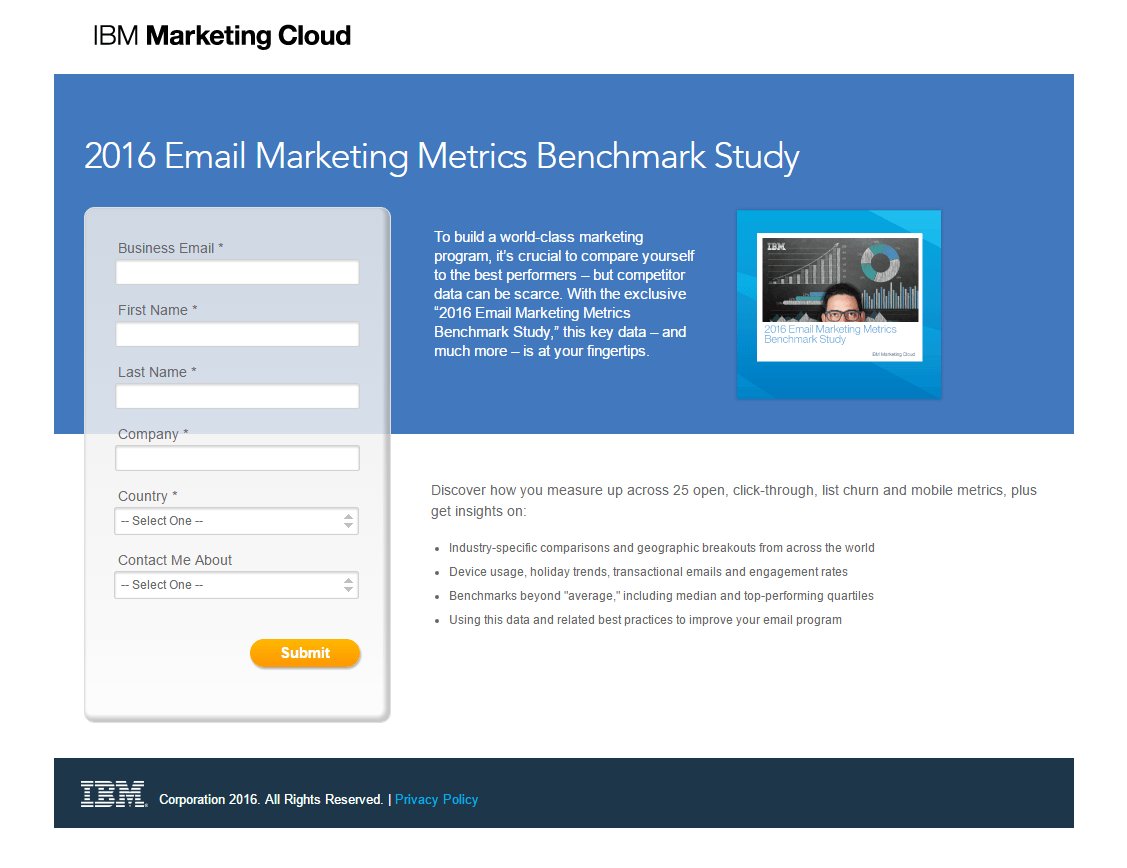
What they did well:
- The headline offers up a valuable resource.
- This CTA button color contrasts the form it’s on well.
- The image serves as a visual representation of the offer.
What to A/B test:
- The CTA “Submit” can’t get any more unremarkable.
33. HubSpot

What they did well:
- The headline communicates a clear benefit.
- Bulleted copy quickly communicates the benefits of converting.
- The CTA button color pops on this page’s background.
What to A/B test:
- The HubSpot logo is linked to their homepage, which allows easy access off the page and can reduce the number of conversions for the free assessment.
- The long form might scare prospects off this page before they convert.
34. Dreamforce

What they did well:
- Bulleted copy quickly communicates the benefits of converting.
- The CTA button color pops on this page’s background.
What to A/B test:
- A busy footer distracts prospects from converting, allowing them to abandon the page whenever they please.
- The share button at the end of the form allows visitors to leave the page.
- The button copy could be made relevant to the offer.
35. Capital One
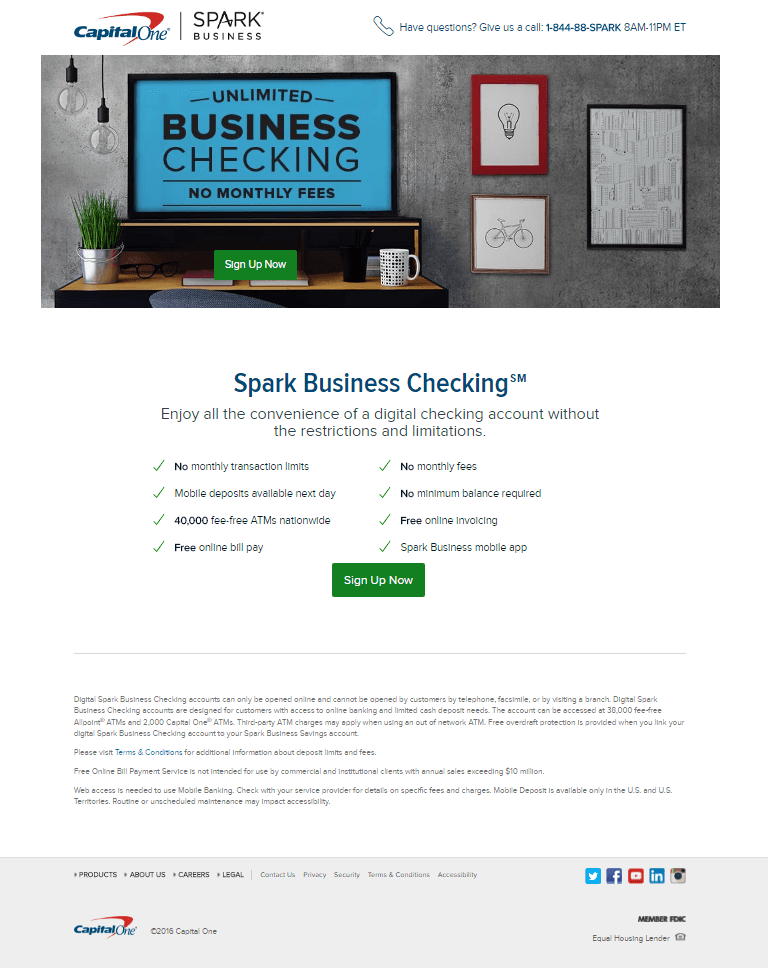
What they did well:
- The headline clearly communicates the value of the offer.
- Bulleted copy quickly communicates the benefits of converting.
- Cooperative CTAs help to convert the prospect zt two different places on the page.
What to A/B test:
- A busy footer filled with links and social media icons distract prospects from claiming the offer.
- The CTA “Sign up now” could be more tailored to the offer. Even “Give Me Unlimited Checking With No Monthly Fees” would likely perform better.
36. WordStream
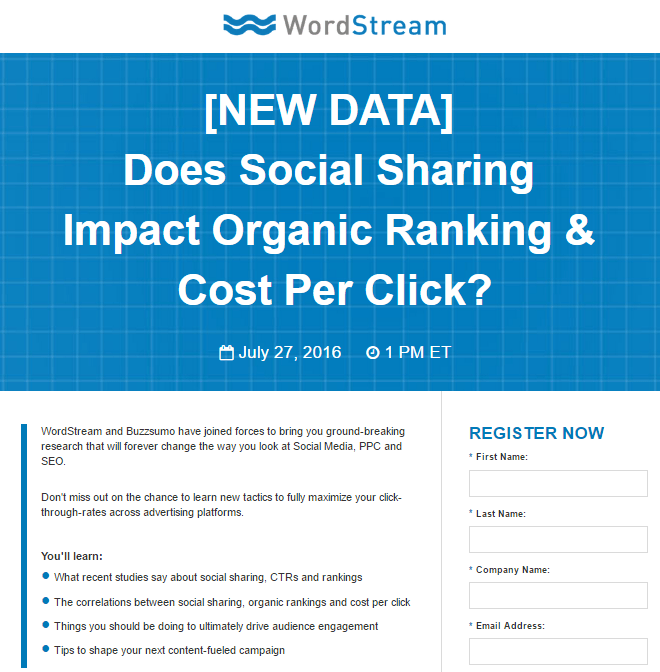
What they did well:
- The question headline engages the reader by speaking directly to them.
- Bulleted copy quickly communicates the benefits of the offer.
- The CTA button color draws prospects' attention.
What to A/B test:
- A footer complete with social media links allows prospects to abandon the page.
- The privacy policy is missing, which might make visitors wonder, “What is WordStream going to do with my information if I submit it?”
37. Marketo
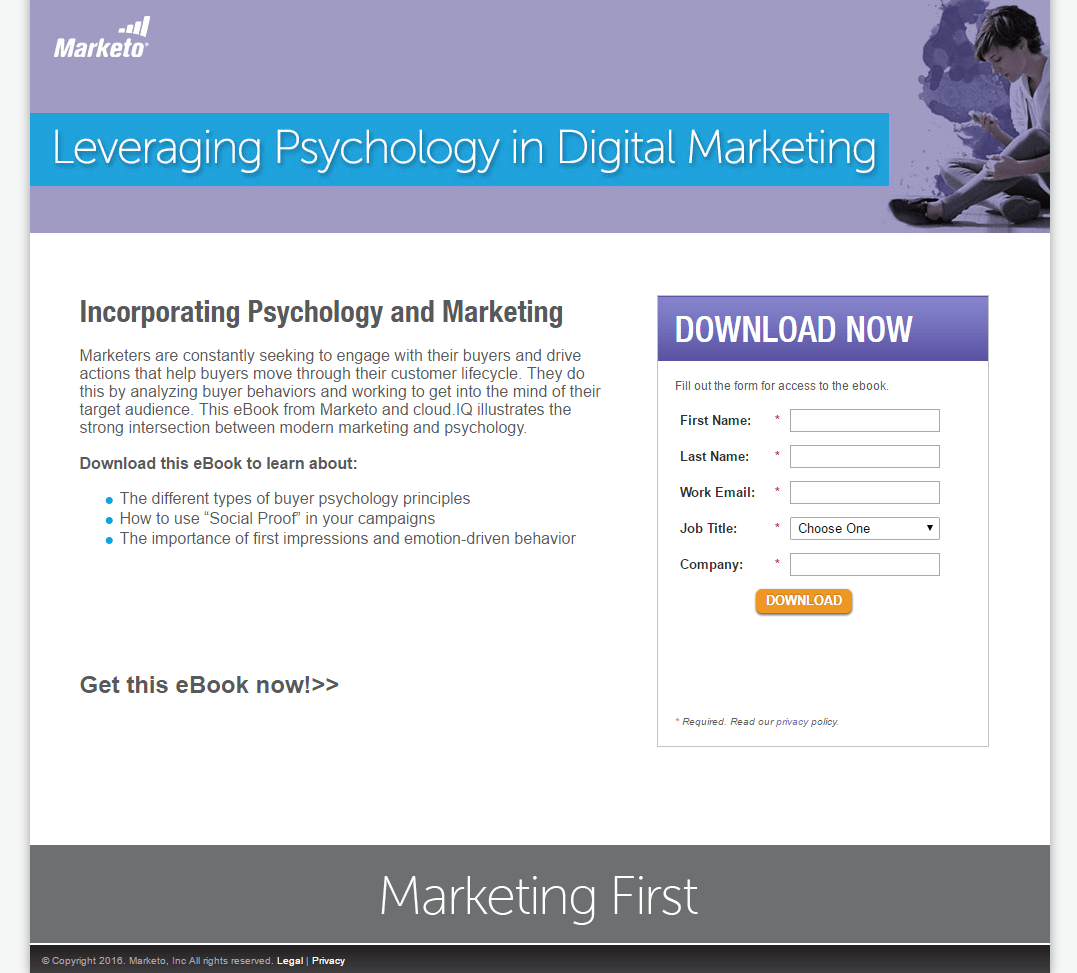
What they did well:
- This CTA button color contrasts the rest of the page well.
- A minimalistic footer doesn’t distract from the offer.
What to A/B test:
- The CTA “Download” is about as uninteresting as it gets.
- The headline could be worded to convey a stronger benefit.
38. Autopilot

What they did well:
- This case study headline offers a valuable resource: An in-depth look at how Instapage generated $30k in revenue in two months.
- This CTA is written in the first person.
- Images humanize the presenters.
- Bulleted copy conveys the benefits of attending the webinar.
- Titles of the presenters showcase their expertise.
- A countdown timer leverages scarcity.
What to A/B test:
- Speaker bios could have a bit more detail, convincing visitors to attend.
39. On24
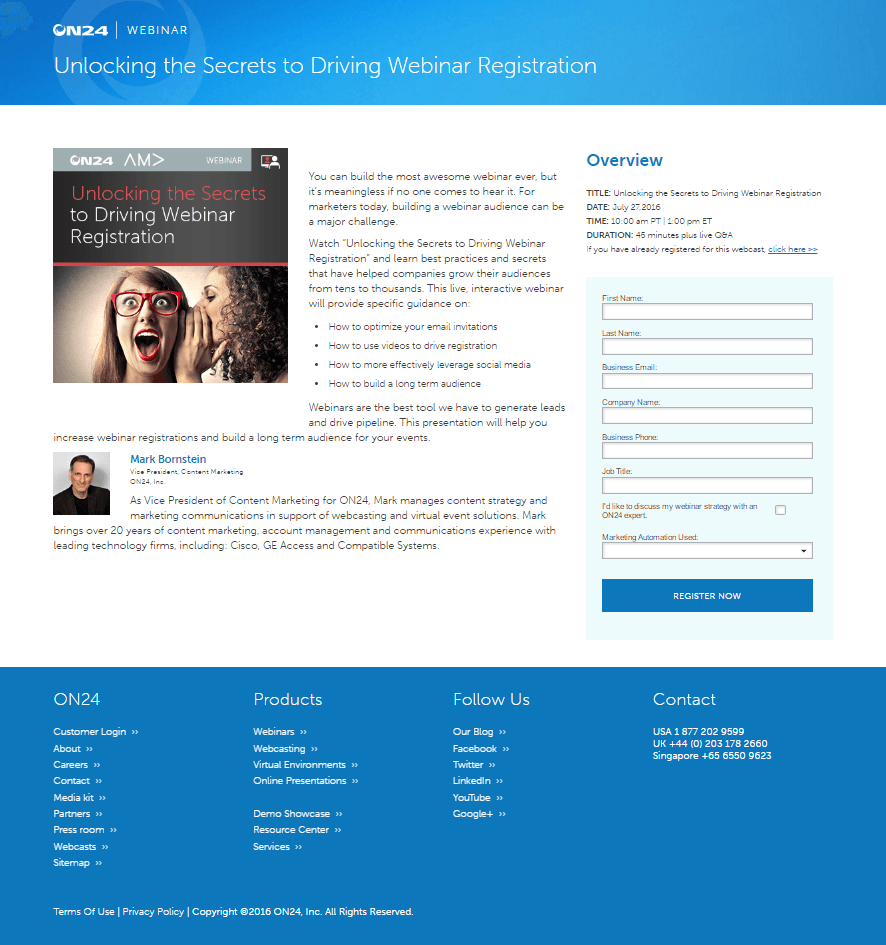
What they did well:
- The headline offers to let visitors in on little-known “secrets” that will help them boost webinar registration.
- The word “Now” in the CTA emphasizes the immediate benefit of clicking the button.
What to A/B test:
- The CTA button color is used a lot on the page already, making the button easily missable.
- The navigation footer serves no purpose on a landing page.
40. Domo
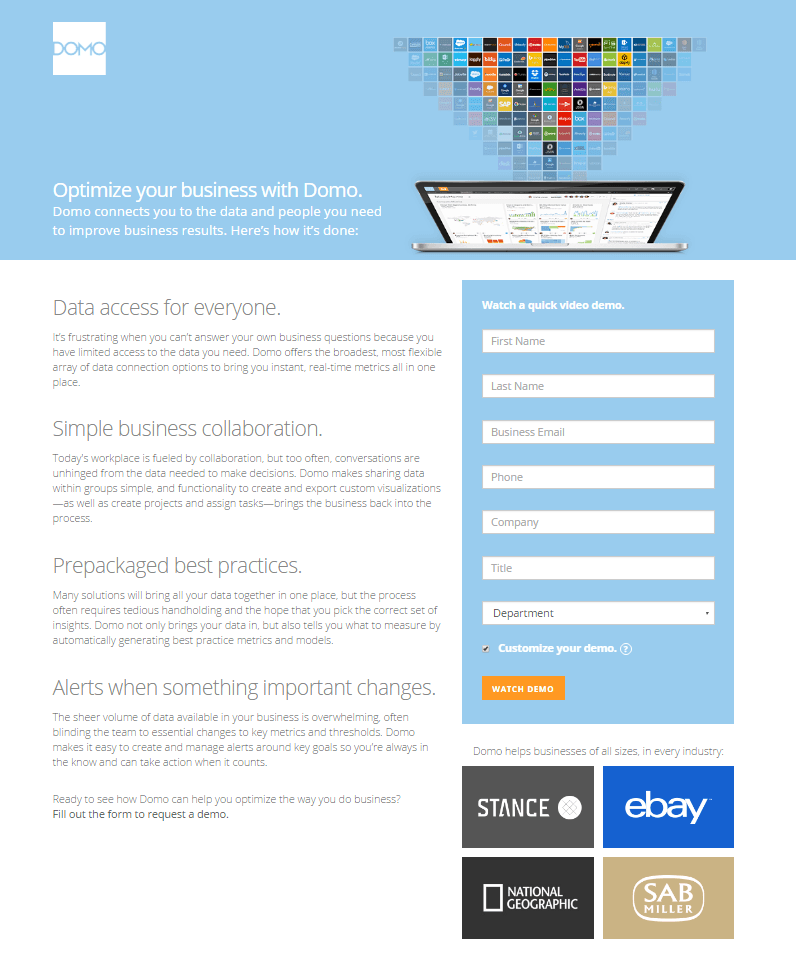
What they did well:
- The headline communicates a clear benefit.
- Copy separated into small chunks makes reading this page less of a chore.
- The CTA button color pops on this form’s background.
- Logos of big-name businesses boost authority by aligning the brand with some well-known companies.
What to A/B test:
- This CTA button could be bigger to draw more attention.
- The verbosity of this page could be cut down with some simple bullet points.
- The headline could be moved up a few spaces on the page. It doesn’t look centered on the page.
41. UserTesting
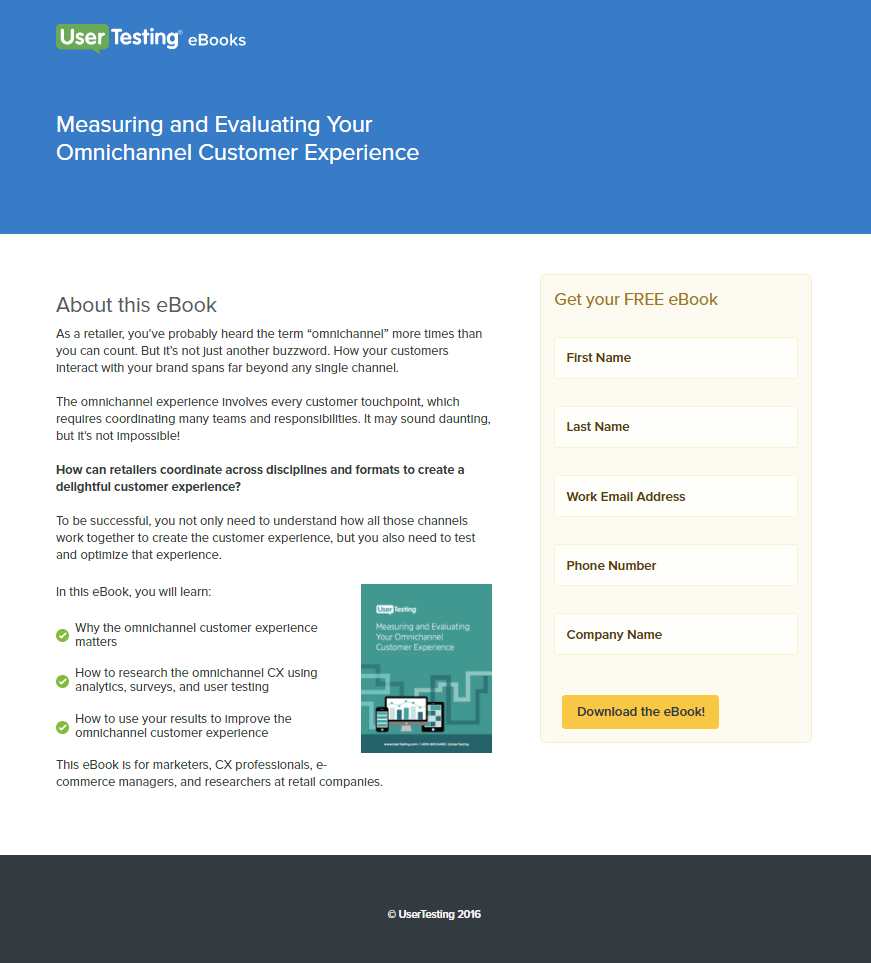
What they did well:
- Bulleted copy quickly communicates the benefits of the offer.
- The word “free” emphasizes the no-cost offer.
- The bright button color draws prospect's attention.
- The image serves as a visual representation of the offer, showing visitors what they’ll get after converting.
What to A/B test:
- The headline could convey a stronger benefit.
- A privacy policy or trust badges may make visitors more comfortable with converting.
42. ACT

What they did well:
- The logo isn’t linked to the homepage, which means visitors can’t escape before they convert.
- The text gives a preview into the content of the ebook.
What to A/B test:
- This headline doesn’t convey a benefit at all.
- Two combating calls to action detract from the conversion rate of each other.
- Tons of text make this page intimidating to read.
43. Villanova University

What they did well:
- Villanova’s logo is not hyperlinked, which keeps visitors on the page and focused on the landing page goal.
- The progress bar shows which step the visitor is currently on, and how many total steps are included in the conversion process.
- Authority badges tout the accolades of the program.
- Bulleted copy quickly convey the benefits of signing up.
What to A/B test:
- The image doesn’t really convey the benefits of Villanova’s online MBA program.
- The CTA button looks nothing like a button, and everything like a simple progress bar. Where should prospects click to continue the signup process?
44. WordStream

What they did well:
- The word “Free” shows up in two different landing pages, emphasizing the no-cost nature of the offer.
- The CTA button color pops on this page’s background.
- The word “Now” in the CTA capitalizes on our desire to get immediate solutions to our problems.
- Bulleted copy quickly communicates the benefits of converting.
What to A/B test:
- A footer with social media links allows prospects to escape the page without converting.
- Two different linked logos in the header serve as outbound exits off the page.
45. Microsoft Power BI
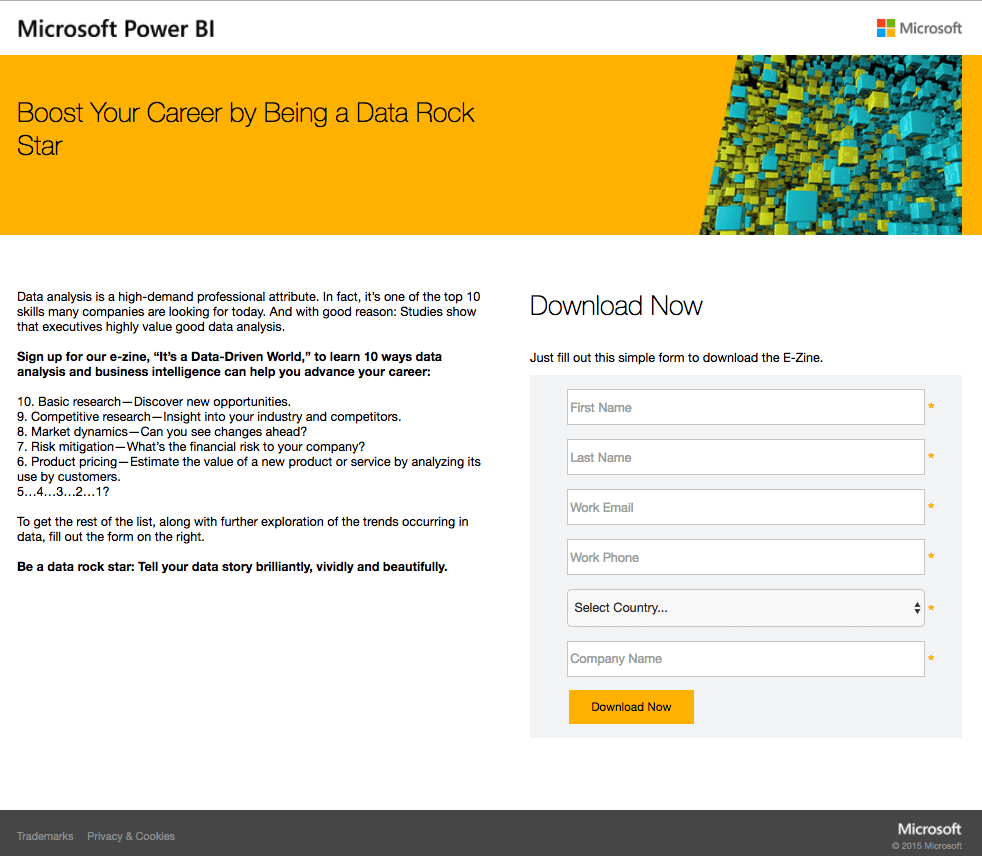
What they did well:
- The headline conveys a benefit to the visitor.
- The copy reinforces the value presented by the headline with the statement “Data analysis is a high-demand professional attribute. In fact, it’s one of the top 10 skills many companies are looking for today.”
- Bulleted copy explains the benefits of downloading the e-zine.
- Bolded letters create a visual hierarchy drawing attention to important phrases.
- Links to privacy policies and trademarks are included as a resource for curious prospects, but they’re also dull in color so as not to steal attention from more important page elements.
What to A/B test:
- Two hyperlinked logos in the header, and one in the footer, draw users to the homepage before they have a chance to convert.
- Light-gray labels within the form fields have the potential to confuse and frustrate prospects, research shows.
46. Marketo

What they did well:
- A logo unlinked to the homepage doesn’t let prospects escape without converting.
- The “How To” headline conveys a clear benefit to the reader.
- The content relates to the reader.
- Skimmable text with bullet points makes this page easy to get through.
- The text “Download the eBook to learn more” with its corresponding arrows lead visitors’ eyes toward the form.
- Instructions on the form let people know exactly how to claim the ebook.
What to A/B test:
- The CTA “Download” could be much more compelling.
- The CTA button would draw more attention if it were bigger.
47. Google Cloud Platform

What they did well:
- The headline offers a valuable, free resource.
- The CTA button color pops on this page’s background.
- Bulleted copy conveys the benefits of converting.
- The FAQ section helps answer any visitor concerns about the platform. However, the inclusion of outside links provide easy ways off the page without first letting the visitor convert on the offer.
What to A/B test:
- The logo in the top-left is hyperlinked to the Google Cloud homepage, which distracts visitors from clicking through on the CTA and “trying it free.”
- A busy footer allows visitors to abandon the page without converting.
48. Shopify

What they did well:
- This CTA button color contrasts the rest of the page well.
- Multiple CTAs work together to convince the prospect to convert.
- The word “Today” in the CTA emphasizes the instantaneous benefit of clicking the button.
What to A/B test:
- A logo linked to the homepage serves as an escape route for prospects.
49. Percolate

What they did well:
- The CTA button color contrasts the white page well.
- Several cooperative CTA buttons work together to convert the prospect.
- The call-to-action is tailored to the offer. It reads “See Percolate” instead of something cookie-cutter like “view demo.”
- Bite-sized content makes reading this page easier than if it were covered in block text.
- Screenshots from inside Percolate give visitors an idea of how it works.
What to A/B test:
- Numerous links in the header and footer serve as exits from the page, allowing prospects to leave before they convert.
- The subheadline claims that Percolate is the world’s #1 content marketing platform, but where’s the proof? Phrases like this do the opposite of what’s intended. Think about it — how many times have you seen “World’s Best Cup of Coffee” written on the outside of a café? And how many times have you believed it?
- These testimonials are given by nameless customers. Without names and titles or photos, they’re less credible to readers. Visitors have to decide whether they believe these were written by Percolate customers, or by the Percolate team themselves.
50. SAP

What they did well:
- No navigation means no visible way off the page.
- Links on the page might have you thinking they direct the prospect elsewhere, but really they just bring you to the bottom of the page to the form.
What to A/B test:
- The image has nothing to do with the offer, and it doesn’t strengthen it whatsoever.
- This headline isn’t benefit-oriented. Why should the visitor download it?
51. Whitman Syracuse University
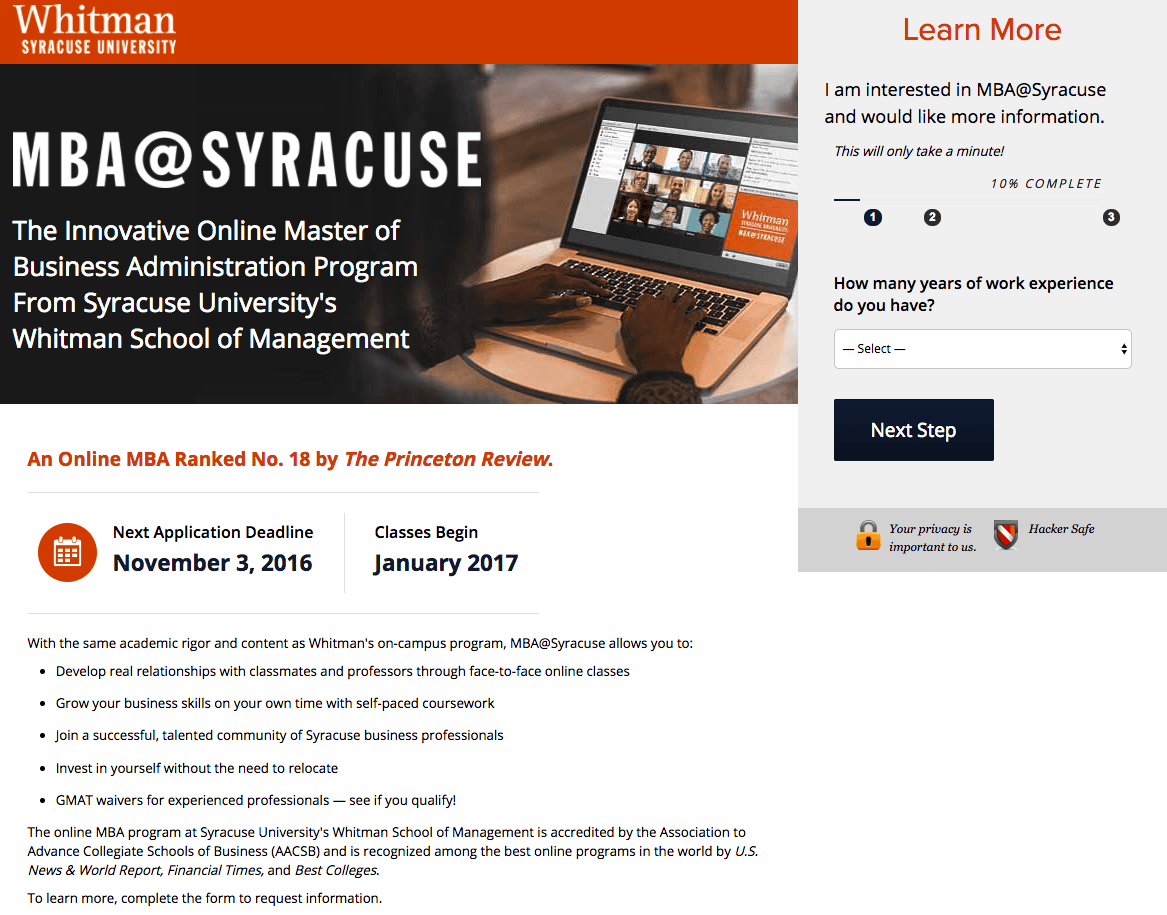
What they did well:
- The registration process is broken up into steps, reducing the friction associated with converting.
- Bulleted copy conveys the benefits of attending the program.
What to A/B test:
- The CTA button color makes this button easily missable.
- The headline is missing a clear unique selling proposition.
52. Online Trading Academy

What they did well:
- The headline relates to the reader by playing to their desires: they want to make the money a Wall Street trader would without being one, or becoming one through long, drawn-out, formal education.
- Logos of big-name businesses boost authority by aligning the brand with some well-known companies.
- Multiple cooperative CTAs work together to convert the prospect.
- This CTA button color draws prospects' attention.
- Contact information gives prospects a way to get in touch with company representatives if they have questions about the offer.
- The phone number is click-to-call, making it easier for prospects to contact Online Trading Academy should they have questions.
What to A/B test:
- The social media links at the bottom of the page distract users from completing the page’s goal.
53. Colonial Life
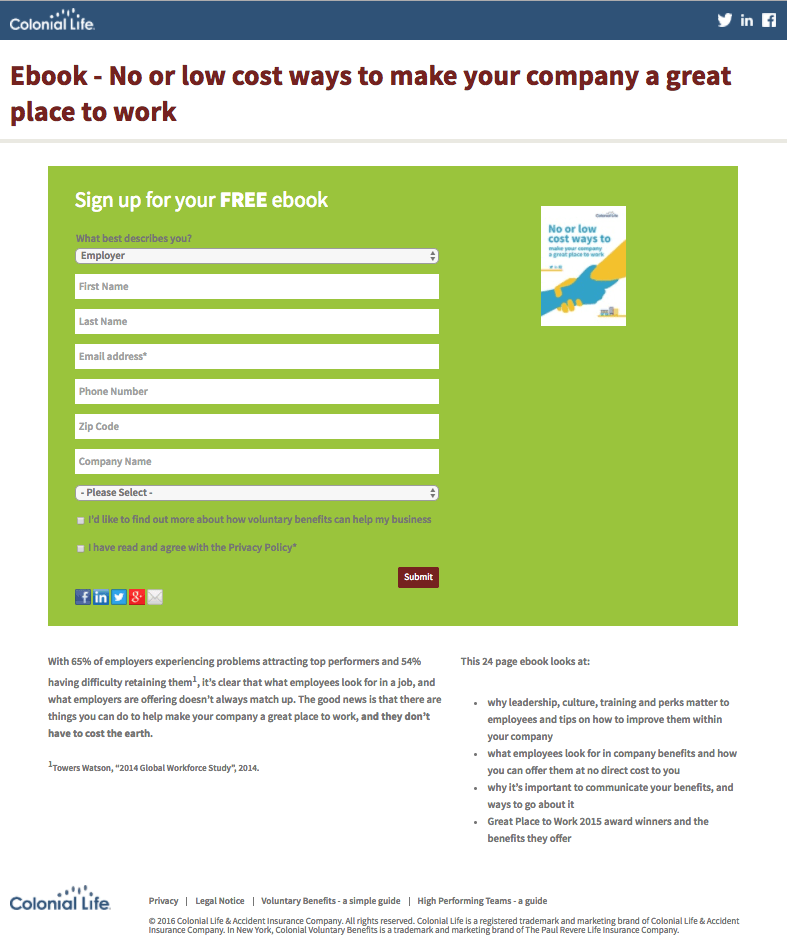
What they did well:
- The image shows visitors what they’ll get when they convert.
- Statistics in the copy prove employers have trouble retaining top talent, making the case for why they should read the ebook.
- Bullet points preview the 24-page ebook’s content.
- The subheadline emphasizes that the ebook is free.
- The opt-in box is unchecked, allowing visitors to choose for themselves if they want to receive additional content from Colonial Life, and not just selected by default.
What to A/B test:
- Links in the header drive visitors away from the page, to the homepage and social media profiles.
- The button copy “submit” doesn’t get users excited about completing the form.
- The CTA button is teeny-tiny and barely noticeable.
54. Oribi

What they did well:
- The headline and subheadline together convey the benefit of converting.
- The image gives an inside look into how the dashboard looks.
What to A/B test:
- The CTA button is blue with Facebook branding, so the rest of the page might benefit from a color update that isn’t the same as the button. The result will be better contrast between the button and the page.
- The word “Free” is underplayed here. If you’re offering something for free, let prospects know in bold letters—in your headline, copy, and CTA.
- The Blog and About us links allow visitors to exit the page.
55. FireEye
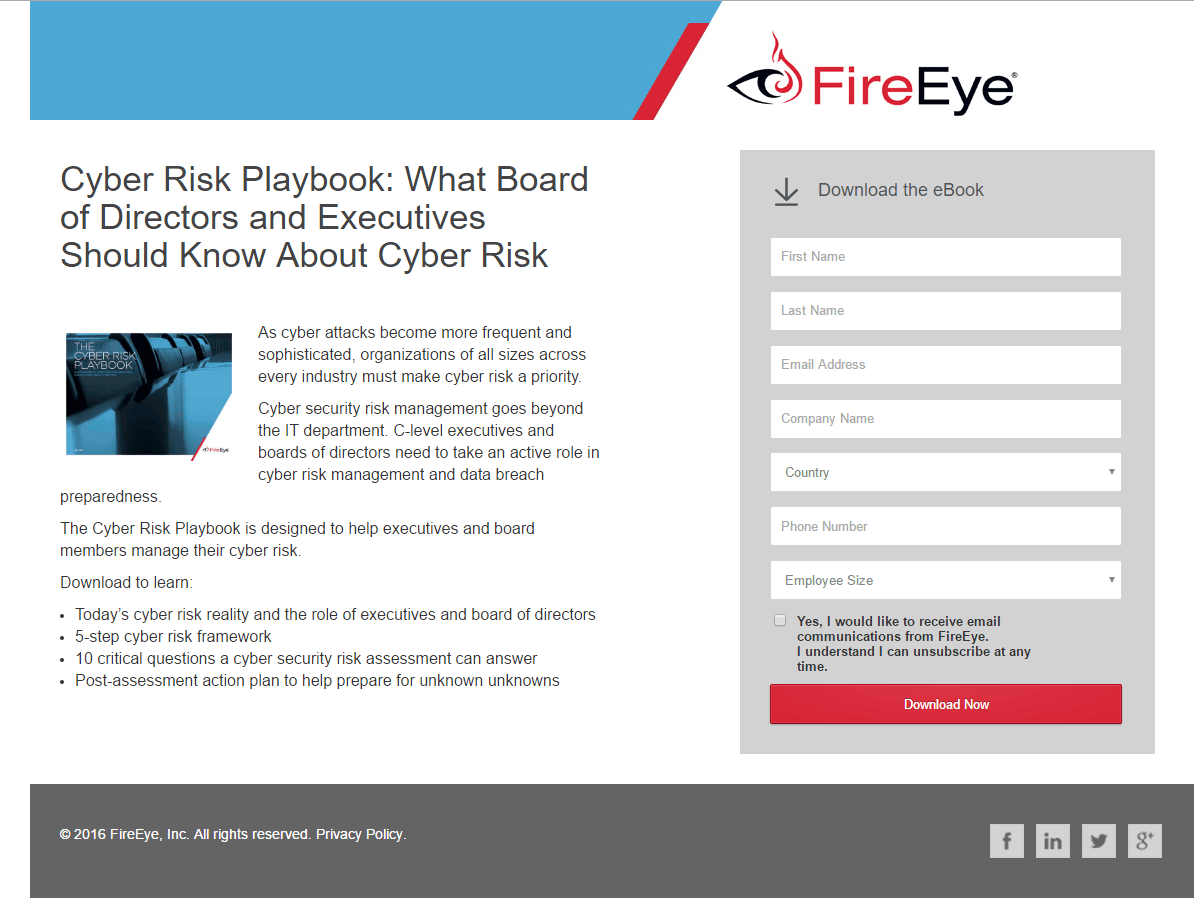
What they did well:
- Bulleted copy quickly communicates the benefits of the offer.
- The CTA button color attracts prospects' attention.
- The image serves as a visual representation of the offer, showing visitors what they’ll get after converting.
What to A/B test:
- The CTA “Download Now” could be better tailored to the offer.
- A footer containing social media links allows prospects to escape the page without converting.
56. Nutanix
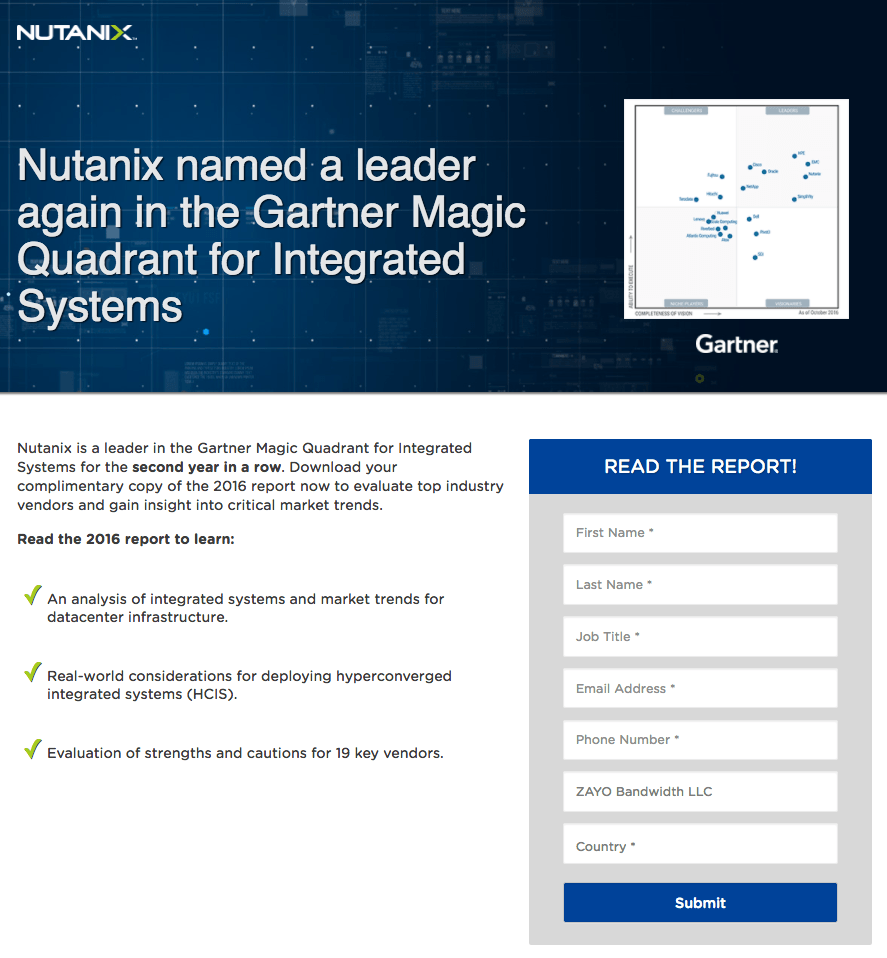
What they did well:
- Bulleted copy gives visitors an idea of what they’ll get in the report.
- Minimal text makes the page easy to read.
What to A/B test:
- This headline is too egocentric. It doesn’t convey a benefit to the visitor whatsoever.
- All-caps text on the form finished with an exclamation point makes the readers feel like they’re being yelled at. You can’t force them to read the form, but you can convince them to.
- A 7-field form may intimidate prospects into abandoning the page.
- The CTA button color doesn’t stand out on a page that already has a fair amount of blue on it.
57. MapR

What they did well:
- A short form makes converting on this page simple.
- Bulleted copy quickly conveys the benefits of converting.
What to A/B test:
- The CTA “Submit” is as unimaginative as they get.
- This headline could convey a better benefit.
- Speaker introductions seem incomplete without the headshots.
58. TapClicks
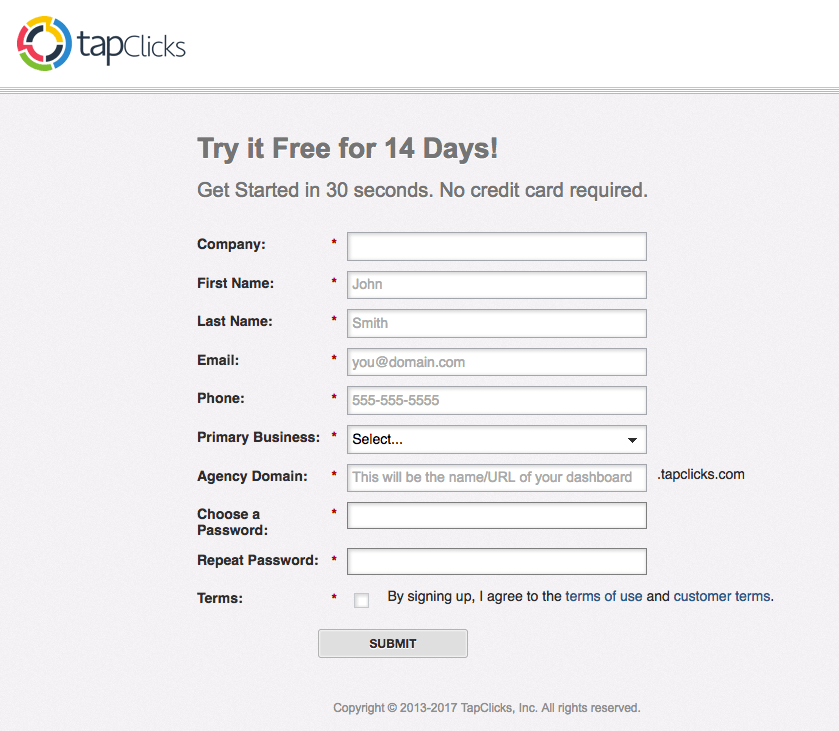
What they did well:
- The word “Free” in this headline lets people know that the offer comes at no monetary cost. Same goes for the text “No credit card required” in the subheadline.
- The copy “Get started in 30 seconds” communicates to the visitor that beginning a trial is quick and easy.
What to A/B test:
- A logo linked to the homepage gives visitors an easy way off this page.
- A lack of content makes it unlikely visitors will fill out this form.
- A 9-field form may intimidate visitors into abandoning this page quickly.
- Light-gray form labels have the potential to frustrate visitors when they disappear once visitors click inside each individual field.
- The CTA button color blends in with the page, making the button itself nearly invisible.
- The call-to-action “Submit” won’t make visitors enthusiastic about converting.
59. Apttus

What they did well:
- The headline communicates a clear benefit.
- Bulleted copy quickly conveys the benefits of converting.
- Testimonials add to the credibility of this offer.
What to A/B test:
- A link-filled footer allows prospects to escape to other pages before converting.
- The button copy could be improved.
60. ThriveHive
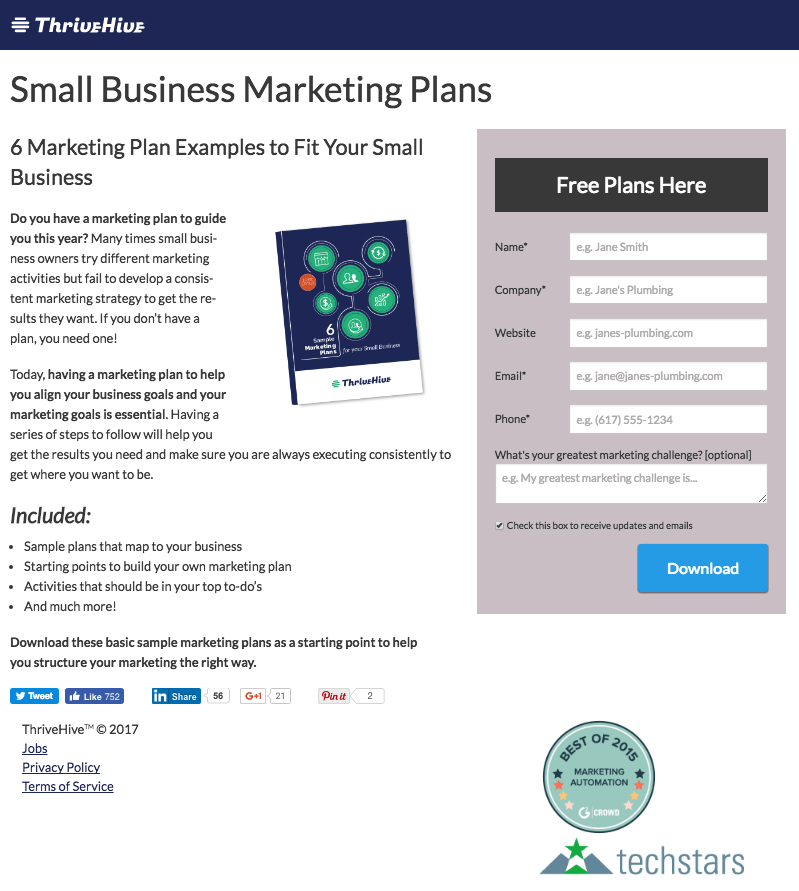
What they did well:
- The headline offers up a valuable resource.
- Bulleted copy quickly communicates the benefits of converting.
- The CTA button color isn’t used anywhere else on the page.
- Badges showcase awards earned by the company.
- The image serves as a visual representation of the offer, showing visitors what they’ll get after converting.
- A short form makes converting on this page simple.
What to A/B test:
- The CTA “Download” is almost as boring as “Submit.” Why not “Send me my plan”?
- The “Free Plans Here” CTA at the top of the form is a little confusing. Why have two CTA buttons that do the same job so close to each other on the page?
61. InsideSales.com

What they did well:
- The headline communicates a clear benefit.
- Bulleted copy quickly communicates the benefits of the offer.
- Logos of big-name businesses boost authority by aligning the brand with some well-known companies.
- The image serves as a visual representation of the offer, showing visitors what they’ll get after converting.
What to A/B test:
- A busy footer with links to other web pages allows prospects to abandon the page.
- The CTA copy may boost conversion rates by using personalized copy. “Download My Ebook” or “Get My Ebook” could potentially convert at a higher rate.
62. Vantiv

What they did well:
- Bulleted copy quickly conveys the benefits of the offer.
- The CTA button stands out on the white background.
What to A/B test:
- The button copy “submit” doesn't get the reader excited about converting.
- The headline doesn’t grab the reader. It conveys no benefits whatsoever.
- All form fields are required, which could cause visitors to pause and not download the ebook. We understand if name and email are required, but is organization and phone number truly necessary for Vantiv to send visitors the ebook?
63. Urban Airship

What they did well:
- A short form makes converting on this page simple.
- Bulleted copy quickly communicates the benefits of the offer.
What to A/B test:
- The call-to-action “Register” could be changed to something more compelling.
- This CTA button color blends in with the majority of the page.
- Headshots of the speakers would give the page more credibility and increase human appeal.
64. WalkMe

What they did well:
- The headline and subheadline convey a clear benefit.
- Bulleted copy quickly communicates the benefits of the offer.
- The CTA button color draws prospect's attention.
- The call-to-action emphasizes the free offer.
- Logos of big-name businesses boost authority by aligning the brand with some well-known companies.
What to A/B test:
- Adding white space and letting each element breathe would really help maximize their attention and persuade prospects to get started with WalkMe.
- Making the CTA button larger could draw generate more clicks (although adding more white space around the current CTA would also help with this).
65. AdEspresso University

What they did well:
- The headline speaks directly to readers and offers to make their lives easier.
- Logos from big-name businesses add authority to the offer by aligning the brand with some well-known companies.
- Bite-size sections of copy quickly describe the contents of the course.
What to A/B test:
- The primary CTA button ‘Subscribe Now’ isn’t meant for visitors who don’t have an AdEspresso account, but, they don’t find this out until they have clicked the button. New users can only subscribe to the offer if they click the ‘login’ CTA at the top of the page. This is confusing and a little misleading.
66. Sundays

What they did well:
- The headline and sub-headline lets the visitors know exactly why they need to get their hands on Sundays’ furniture. The bullet points explain the features in a succinct way.
- The Black Friday offer is clearly visible on the page
- The images are relevant and give the visitors a nice of preview of what the furniture looks like
- The FAQ section helps the visitors learn more about the brand and the furniture
- The As Seen In section helps establish credibility
What to A/B test:
- There are a ton of navigation links on the landing page giving visitors an escape route to move away from the conversion goal.
67. NORI
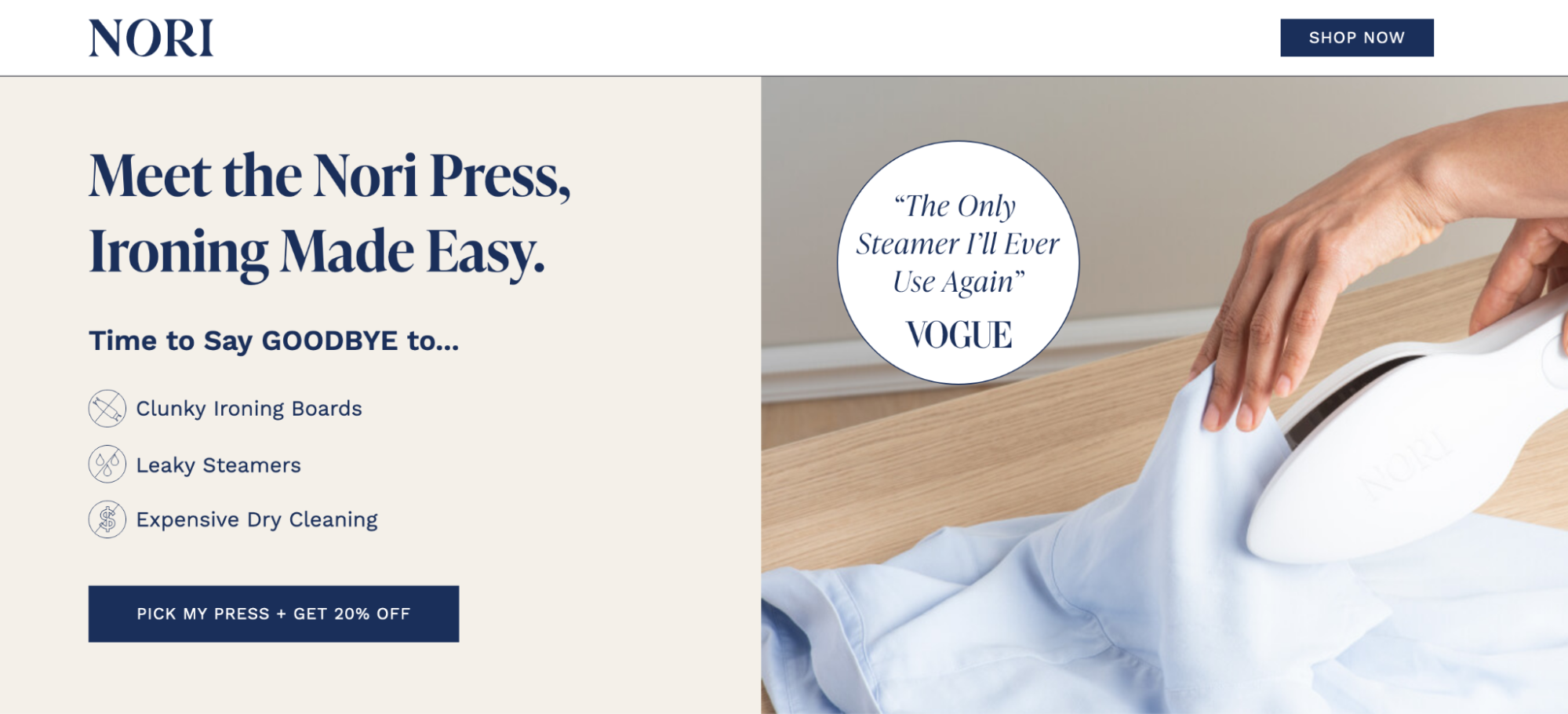
What they did well:
- The headline and sub-headline come together to explain what the product is and everything the visitor will get rid of once they get the handheld steamer
- The short press snippet from Vogue in the hero section adds a lot to the credibility of the offer
- The CTA button copy mentions the 20% off offer to persuade visitors to get Nori Press
- The page also features customer testimonials, a competitive grid, and FAQs to help visitors make an informed decision
68. Jiggy Puzzles

What they did well:
- The headline, though short explains the concept of Jiggy Puzzles completely
- All the images are beautiful and relevant to the product the page is selling
- The customer testimonials and press features help with credibility
What to A/B test:
- The page seems a little cluttered, which could confuse visitors
- There are multiple navigation links on the page which provide visitors exit routes to leave the page
69. Hint
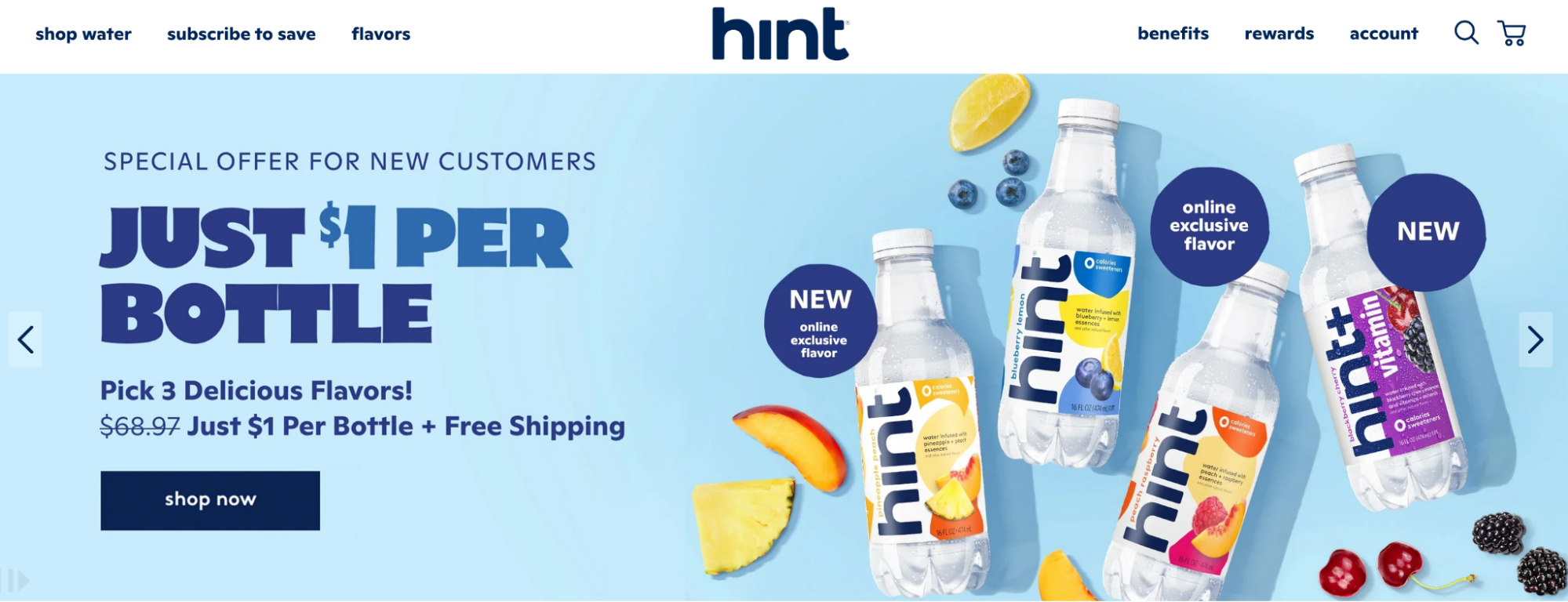
What they did well:
- The page design is vibrant and relevant. The bottles and ingredients give an amazing aesthetic appeal to the page
- The subscribe to save section explains what the offer is and how visitors can get it
- The “you’ll find” section showcases all the benefits users can get access to when they shop Hint water
- The headline needs more clarity and oomph. It doesn’t explain why Hint water is good for users.
- There are multiple navigation links on the page that give visitors a way to escape the page without signing up
- The headline gets the UVP of the product across succinctly
- The pictures of the beef jerky are enticing and show the visitors what the product will look like
- The product description is short and gets the point across
- The discount offer entices visitors to hit the “add to cart” button
- The founder story is heart warming and allows users to connect with the brand
- The customer testimonials helps visitors see what others like about the jerky
- The page does a very good job with all the landing page elements, as is, there’s nothing glaring we could find that needs A/B testing
- The headline offers a valuable resource.
- The image serves as a visual representation of the offer, showing visitors what they’ll get after converting.
- A footer with social media links allows visitors to escape without converting on the page.
- The headline is a statement that isn’t very user-oriented. it doesn’t talk about why the visitor would want the survey or why it is important.
- The headline communicates a clear benefit.
- The one-click signup makes converting a breeze.
- Logos of well-known companies align this brand with trusted businesses.
- The copy “in seconds” takes advantage of our desire for instant gratification.
- The FAQ section has exit links to the support center and pricing page that lead the visitor off the landing page.
- This CTA button color contrasts the rest of the page well.
- Bulleted text quickly lets visitors know what they’ll get by attending a ConnectWise Roadshow.
- This headline doesn’t communicate a clear benefit.
- “Register now” is a boring CTA.
- Links to maps of roadshow locations let prospects escape the page too easily.
- A long form makes converting here intimidating.
- The headline offers a valuable resource.
- The super-short, one-field form makes converting a breeze.
- Some copy below the form ensures privacy.
- This ghost CTA button is easy to miss.
- The form right below the headline seems prematurely placed. A sub-headline to elaborate on what the product is would be helpful.
- The headline offers up a valuable resource.
- Bulleted copy quickly communicates the benefits of the offer.
- The CTA button color pops on this page’s background.
- The word “Now” in the CTA capitalizes on our inherent desire for instant gratification.
- Social media links allow prospects to escape the page without converting.
- The drop-down form fields are not labeled which can be confusing.
- The headline communicates a benefit.
- Bulleted copy quickly communicates the benefits of converting.
- The CTA button color pops on this page’s background.
- The word “Now” in the CTA emphasizes the instantaneous benefit of clicking.
- The image serves as a visual representation of the offer.
- The arrow acts as a visual aid, guiding the prospect's eyes toward the CTA button.
- Social sharing buttons have been shown to perform better on “thank you” pages, where prospects can share with their networks after determining the value of your offer.
- A non-hyperlinked logo doesn’t let prospects escape the page through it.
- The benefit of converting (earning $7k) is highlighted on the page.
- The copy is broken into easily readable chunks that explain step-by-step how to earn the $7,000 referenced on the landing page.
- Two cooperating CTAs work together to convert the prospect at different spots on the page.
- Company logos showcase known brands that have already used the service.
- A minimalistic footer doesn’t distract prospects from converting with links to other pages or social accounts.
- The headline is unreadable on the white background.
- The footer is linked to the homepage providing an easy way for visitors to leave the page without converting.
- Not cutting off the faces of the people in the image.
- The headline offers a valuable resource: predictions from experts that will allow you to start planning for 2027.
- Bulleted copy quickly communicates the benefits of downloading the guide.
- The CTA button color isn’t used anywhere else on this page, and it draws attention against a white background.
- A logo linked to the homepage gives visitors an easy way to escape this page.
- The CTA copy “Submit” won’t convince users to download this report.
- Links to social media accounts in the footer give prospects more ways off the page.
- The headline offers a valuable resource: An ultimate guide to managing 50+ WordPress sites.
- The image gives an inside look into what reading the resource is actually like.
- The CTA button color pops off the blue background.
- Two cooperative CTAs work together to convert the prospect.
- The CTA “Download” won’t get the prospects excited about claiming the offer.
- Logos of big-name businesses boost authority by aligning the brand with some well-known companies.
- Bulleted copy quickly conveys the benefits of signing up.
- The CTA “Continue” won’t get the prospect excited about signing up.
- The CTA button color makes this button easy to miss.
- The headline leverages the authority of well-known screenwriter Aaron Sorkin to drive signups.
- The CTA button pops off the black page.
- The sticky bar allows the red “Take the Class” CTA to always be available and ready to click.
- The video quickly explains why this course is worth it.
- Links to other pages allow visitors to leave without converting.
- Bulleted copy quickly communicates the benefits of the offer.
- The CTA button color attracts prospect attention.
- The images give an inside look into what using the product is actually like.
- Testimonials strengthen the offer with social proof.
- Logos of big-name brands align the company with trusted brands.
- A footer containing social media links allows prospects to escape the page without converting.
- Bulleted copy quickly communicates the benefits of converting.
- The word “Now” in the CTA capitalizes on our desire for instant gratification.
- This headline doesn’t convey a benefit at all.
- This CTA button color has already been used multiple times on the page. Therefore, it’s not as attention-grabbing as it could be.
- The headline uses words like “exclusive” and “free” to entice readers.
- Minimal copy makes this page easy to read.
- A photo shows what the ebook looks like.
- Bulleted copy previews the book’s content.
- Company logos showcase the well-known businesses that use Zurple nationwide.
- A logo linked to the homepage allows users to exit before converting.
- The button copy “Submit” could be replaced with something more compelling.
- The responsiveness of this page means that when the window is adjusted or the page is viewed on a device with a smaller screen, it will still display flawlessly.
- Labels above each form field won’t confuse prospects like disappearing ones within each form field will.
- The “home” link and the logo both drive users off the page before they have a chance to click the CTA button.
- A lack of content on this page means visitors don’t know the benefits of downloading the report.
- “Submit” as a CTA won’t compel many prospects to download.
- Bolded words create a visual hierarchy, drawing attention to important phrases.
- Benefit-oriented copy describes the advantages of choosing Serena.
- This headline is too “me” focused, and doesn’t do a good job of emphasizing a benefit to the reader. Why should prospects use Serena? What have other businesses accomplished with it?
- The term ITSM is used on the page numerous times, but it’s not completely clear to the prospect what it means.
- A hyperlinked logo serves as an escape route for visitors before they convert.
- Numerous outbound links in the footer tempt users to leave the page.
- The PDF icon with a downward pointing arrow looks like it could be a button, and it may even confuse prospects into thinking that’s what they have to click to download. Additionally, even if it doesn’t, the arrow points toward the exit links in the footer. Your visual cues should guide prospects toward your CTA button, not away from it.
- The call-to-action doesn’t make it clear that the user needs to click to claim the report. It says “Click Here,” but for what?
- The CTA button could look more like a button. Some shadowing around the edges to give it a 3D look, or more rounded corners might make it more clickable-looking.
- The headline offers a valuable resource.
- Bulleted copy quickly communicates the advantages of converting.
- The CTA button color pops on this page’s background.
- The image serves as a visual representation of the offer, showing visitors what they’ll get after converting.
- The word “Now” capitalizes on our desire for instant gratification.
- The CTA “Download Now” is too generic.
- Too many social media links can take visitors off the page.
- The headline offers a strong benefit.
- Logos from big-name businesses add authority to the offer by aligning the brand with some well-known companies.
- This CTA capitalizes on our desire to get something for nothing by using the word “Free.”
- Multiple competing CTAs work against each other by advertising several offers.
- The headline cites a well-known copywriter who’s made millions of dollars writing direct mail campaigns for companies both big and small, and it offers the resource for just $11.
- This CTA button color pops on this page’s background.
- This CTA is written in the first person.
- The word “Now” in the CTA takes advantage of our desire for instant solutions to our problems.
- The image serves as a visual representation of the offer.
- The secondary CTA link just below the first one might confuse visitors. Which do they click to claim the offer? Why are there two right next to each other?
- A navigation menu allows prospects to leave the page before converting.
- The headline communicates a clear benefit, using statistics to make it even more compelling: “that generated $400,10.”
- The CTA button color pops on this page’s background.
- The CTA is written in the first person.
- The image serves as a visual representation of the offer.
- A short form makes converting on this page simple.
- Company logos of big brands boost authority by aligning this company with trusted businesses.
- A hyperlinked logo allows prospects to escape this page before converting.
- The headline and subheadline together promise a benefit to those who convert: exclusive access to 180 blog post ideas sent directly to their inbox.
- The “Yes Please” CTA button uses a bright color to draw attention.
- A two-field form makes converting simple for prospects.
- The yellow text is difficult to read on the page’s background.
- Labels within form fields have the potential to confuse and frustrate visitors, studies show.
- The headline offers a valuable resource.
- The CTA button color draws prospects' attention.
- All of the CTAs are written in the first person.
- These CTAs capitalize on our desire to get something for nothing by using the word “Free” right in it.
- The image serves as a visual representation of the offer.
- More images give a sneak peek into the guide.
- Testimonials serve as social proof, adding credibility to the offer.
- The copy “+1 bonus trick you can’t miss” is surrounded by a rectangle, making it look like a button even though it’s not. Designs like this can confuse prospects into thinking that the page hasn’t fully loaded or the button isn’t working.
- Outbound links in Johnathan Dane’s bio may drive traffic off the page.
- Bulleted copy quickly communicates the benefits of the offer.
- The CTA capitalizes on our desire to get something for nothing by including the word “Free.”
- The image serves as a visual representation of the offer, showing visitors what they’ll get after converting.
- This CTA button color could be more attention-grabbing.
- A busy footer containing links to other web pages allows prospects to abandon the page before converting.
- The copy could be shortened; right now the page looks too copy-heavy.
- The “How To” headline conveys a clear benefit.
- Numbered copy quickly conveys the benefits of downloading.
- This CTA button color contrasts the rest of the page well.
- The image serves as a visual representation of the offer.
- Social share buttons have been shown to perform better on “thank you” pages after your converted leads have had a chance to read through your resource and decide whether it’s worth sharing.
- The “How to” headline conveys a clear benefit tied to a powerful statistic.
- Bulleted copy quickly communicates the benefits of converting.
- This CTA button color contrasts the rest of the page well.
- The CTA is written in the first person.
- A logo linked to the homepage allows prospects to escape without converting.
- The text ‘Where should I send your video’ seems unnecessary—the CTA button copy seems sufficient.
- Badges from Google, Inc 500, and Yahoo align 180fusion with some powerful brands.
- Testimonials tout the benefits of working with this agency.
- Logos of big-name businesses boost authority by aligning the brand with some well-known companies.
- The “busyness” of this page draws prospects’ eyes every which way. With all the colorful and attention-grabbing elements, where should they look?
- A logo linked to the homepage allows prospects to escape without converting.
- The question headline directly engages the reader.
- Logos of big-name businesses boost authority by aligning the brand with some well-known companies.
- This CTA button color contrasts the rest of the page well.
- Multiple CTAs work together to convert visitors.
- A logo linked to the homepage is a potential leak on this landing page.
- The autoplay video forces visitors to watch even if they don’t want to.
- The navigation links in the footer have the potential to drive traffic away from this landing page.
- The case study headline offers a step-by-step solution for landing “High-Ticket Web Design Clients.”
- Logos of big-name businesses boost authority by aligning the brand with some well-known companies.
- The CTA button color pops off the white background of the page well.
- The word “Now” in the CTA emphasizes the immediate benefit of pressing the button.
- A big block of fine print in the footer could make prospects question the offer's validity.
- The CTA button here is impossible to miss.
- The headline emphasizes that the solution is quick and easy.
- An image shows the prospects what they’ll get when they convert.
- A privacy message lets visitors know that their information is 100% secure and that it won’t be shared with any other business.
- All-caps makes the reader feel like they’re being yelled at. It also screams “salesy.” You never want to come across as salesy, even when you’re selling.
- The headline is grammatically incorrect. What’s supposed to be in quotations? If it’s both the headline and the words “Tech Overwhelm,” then it should look like this, “Use This New Template To Quickly Set Up an Automated Lead Generation Funnel With Zero ‘Tech Overwhelm.’” But, why is the headline even in quotations anyway?
- The symbols on the CTA button are supposed to mean what, exactly? Are those arrows?
- The “How to” headline is a classic way of implying the reader will learn something from the offer.
- The CTA button color pops off the page.
- A minimalistic footer doesn’t distract from the offer.
- A long form with many required fields makes this page intimidating to convert on.
- The CTA “download” could be updated to something far more compelling.
- Bulleted copy quickly communicates the benefits of converting.
- Two cooperative CTAs work together to convince prospects to convert.
- Both CTAs are written in the first person.
- The CTA button color pops on this page’s background.
- The warning and countdown timer uses scarcity to boost conversions.
- Adding speaker bios could persuade visitors to sign up for the workshop.
- The social media links in the right-page column are unnecessary and take visitors away from the page.
- A non-hyperlinked logo in the upper-left area keeps prospects from escaping through it to the homepage.
- A short form doesn’t deter visitors from submitting their personal information.
- Bullet-pointed copy quickly conveys the benefits of converting.
- A bright, bold CTA button draws the attention of prospects.
- The image serves as a visual representation of the offer, showing visitors what they’ll get after converting.
- A minimalistic footer doesn’t distract prospects from converting with links to other pages or social accounts.
- The headline is “me” focused but it should be more focused on the visitor and how the product solves their problem.
- All the copy on this page is egocentric: “What we are doing differently,” why marketers “should consider us.” This page isn’t about you, it’s about your visitor.
- The case study headline offers a clear benefit – an in-depth look at how one man gets 30-50 consulting clients monthly.
- The CTA button color pops on this page’s background.
- The button is big, which draws the prospect’s attention to it.
- CTA is written in first person: “Reserve MY Seat” instead of “Reserve YOUR Seat.”
- The word “Now” in the CTA conveys an immediate benefit that comes with clicking the button.
- Autoplay video has been shown to decrease conversions. If visitors want to watch your video, they’ll press the “play” button.
- The headline communicates a clear benefit while offering a “beginner-friendly” offer.
- This CTA button color pops off the page, drawing prospect attention well.
- This CTA is written in first person.
- An arrow serves as a visual aid to guide the prospect’s eyes to the CTA button.
- Testimonials from well-known figures strengthen the persuasiveness of this landing page.
- The word “free” emphasizes the no-cost nature of the offer.
- This busy footer gives prospects far too many ways to abandon the page.
- Bulleted copy quickly conveys the benefits of converting.
- An image shows prospects what they’ll get when they click the “Download Now” button.
- The headline offers a step-by-step method for generating traffic.
- A link to the contact page in the footer could be replaced with a phone number or email address to keep prospects on this page.
- Multiple font formats make this page a little difficult to read. The headline is bolded red, a blue highlighted phrase, bold text within the bulleted copy, etc. Simplifying the format could eliminate friction and keep visitors on the page longer, encouraging them to convert.
- The case study headline offers a clear benefit: A step-by-step guide to generating clients.
- Copy next to the green checkmarks convey the benefits of watching the video.
- The CTA is written in the first person.
- The CTA button color draws prospects' attention.
- Screenshots show happy customers.
- A footer complete with a link to the homepage allows prospects to escape this landing page.
- The headline communicates a clear benefit.
- Bulleted copy quickly communicates the benefits of the offer.
- The image serves as a visual representation of the offer, showing visitors what they’ll get after converting.
- The CTA button could be bigger and include personalized copy.
- The form is really long considering the offer is only one free chapter from the book. Are the fields “Title,” “Role,” and “Phone” necessary for this page?
- A busy, link-filled footer allows prospects to escape this page without converting.
- The CTA button color attracts prospect attention.
- The image serves as a visual representation of the offer, showing visitors what they’ll get after converting.
- The CTA uses the word “Free” and lets visitors know exactly where to click to claim the offer.
- The headline is sensationalized and not believable whatsoever. “How to get anything you want”? Yeah, right.
- The background image makes it appear like the image is floating in space. What does the solar system have in common with the ebook?
- The Facebook “like” button allows visitors to leave the page before converting and never return.
- The headline presents a valuable resource.
- Bulleted copy quickly communicates the benefits of converting.
- The CTA button color attracts prospect attention.
- The image serves as a visual representation of the offer, showing visitors what they’ll get after converting.
- The headline is in quotations – why?
- This CTA uses compelling words like “Free” and “Instant Access,” but without an action verb, it’s not completely clear that the big yellow block is a pushable button. Adding a word like “Get” at the beginning of that, or a phrase like “Push for” would make things more obvious for the prospect.
- The unorthodox headline grabs the reader’s attention.
- Bulleted copy quickly communicates the benefits of the offer.
- The CTA button color attracts prospects' eyes.
- The image serves as a visual representation of the offer, showing visitors what they’ll get after converting.
- The form fields could be rearranged to add to the visual hierarchy of the page and center the CTA button.
- The headline offers up a valuable resource, and uses the word “Free.”
- Bulleted copy quickly communicates the benefits of converting.
- This CTA is written in the first person.
- The image serves as a visual representation of the offer, showing visitors what they’ll get after converting.
- A short form makes converting on this page simple.
- The social media links allow the visitor to exit the page which is never good for conversions.
- A non-clickable logo keeps visitors focused on converting.
- The phone number in the upper-right of the page allows people to contact the business without leaving the page.
- The offer is an “ultimate list,” with 114 niche ideas. A list of 20 is good. A list of 50 is better. 114 sounds even more valuable to the reader.
- The question “Looking for a membership site niche idea?” directly addresses the reader.
- Bulleted copy stresses the benefits of converting.
- Multiple CTA buttons work together to convert the prospect.
- Text on the form lets people know where the link is going, and how long it should take for it to get there.
- The CTA button under the form is written in first-person.
- The two-field form makes converting a breeze for visitors.
- A link in the footer drives prospects to the site’s homepage.
- The phone number is not click-to-call, which makes contacting the company more difficult than it needs to be.
- The exit pop-up is the same offer as the landing page offer. If someone was abandoning your page because they decided they didn’t want to claim your offer, why would you offer them the same content as a last-ditch attempt at getting their email address?
- The question headline engages the reader.
- The copy promises to reveal a secret.
- This CTA button color contrasts the rest of the page well.
- The call-to-action is written in the first person.
- The blurred image looks unnecessary. Instead of giving space to an image that doesn’t show visitors anything it would’ve been much better if they added more copy and wrote more about their targeting framework.
- The headline conveys a strong benefit, and uses the word “Free.”
- Bulleted copy emphasizes the quick and easy benefits of claiming the offer.
- The CTA button color pops on the form background.
- This explainer video quickly describes the service in plain language.
- The CTA capitalizes on our inherent desire to get something for nothing by using the word “Free.”
- Contact information gives prospects a way to get in touch with company representatives if they have questions about the offer.
- The first line of copy talks about ‘a recent news report’, but doesn’t mention the date so visitors don’t know how recent it is. Sure, there’s a link at the bottom of the form, but it would be better if they clarified things and added a date.
- The CTA button is easy to spot.
- A three-field form makes converting easy.
- The headline emphasizes the free offer.
- The all-caps headline and CTA read like they’re yelling at the prospect.
- This page is simple. Too simple. What’s in the book? Why should we download it?
- This video isn’t too long, but it’s also not too interesting either. Two minutes of writing? That totally defeats the purpose of creating a video.
- A link to the author’s Facebook page drives prospects away before they have a chance to convert.
What to A/B test:
70. Chomps
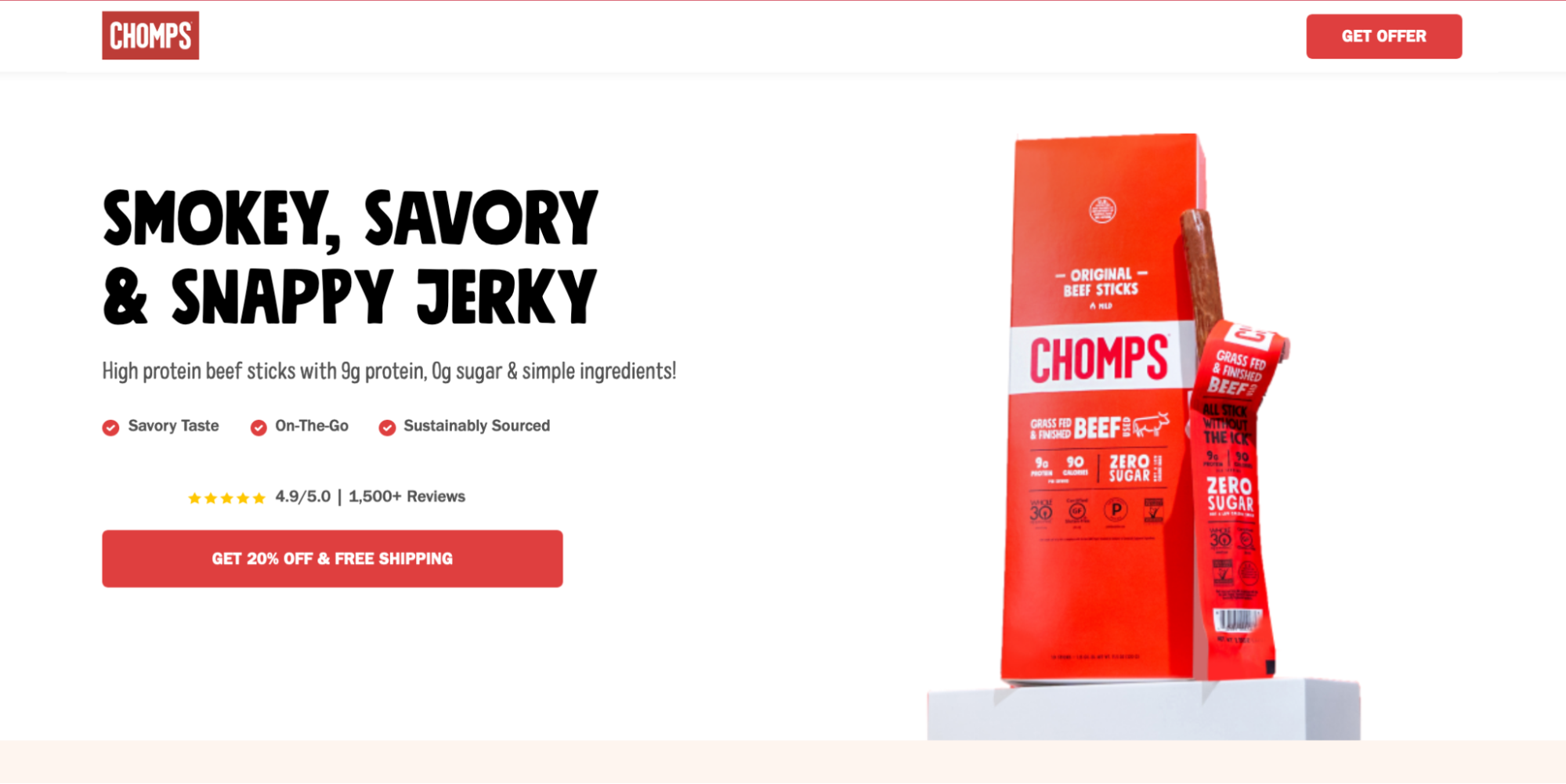
What they did well:
What to A/B test:
71. Kentico

What they did well:
What to A/B test:
72. Strikingly

What they did well:
What to A/B test:
73. LabTech
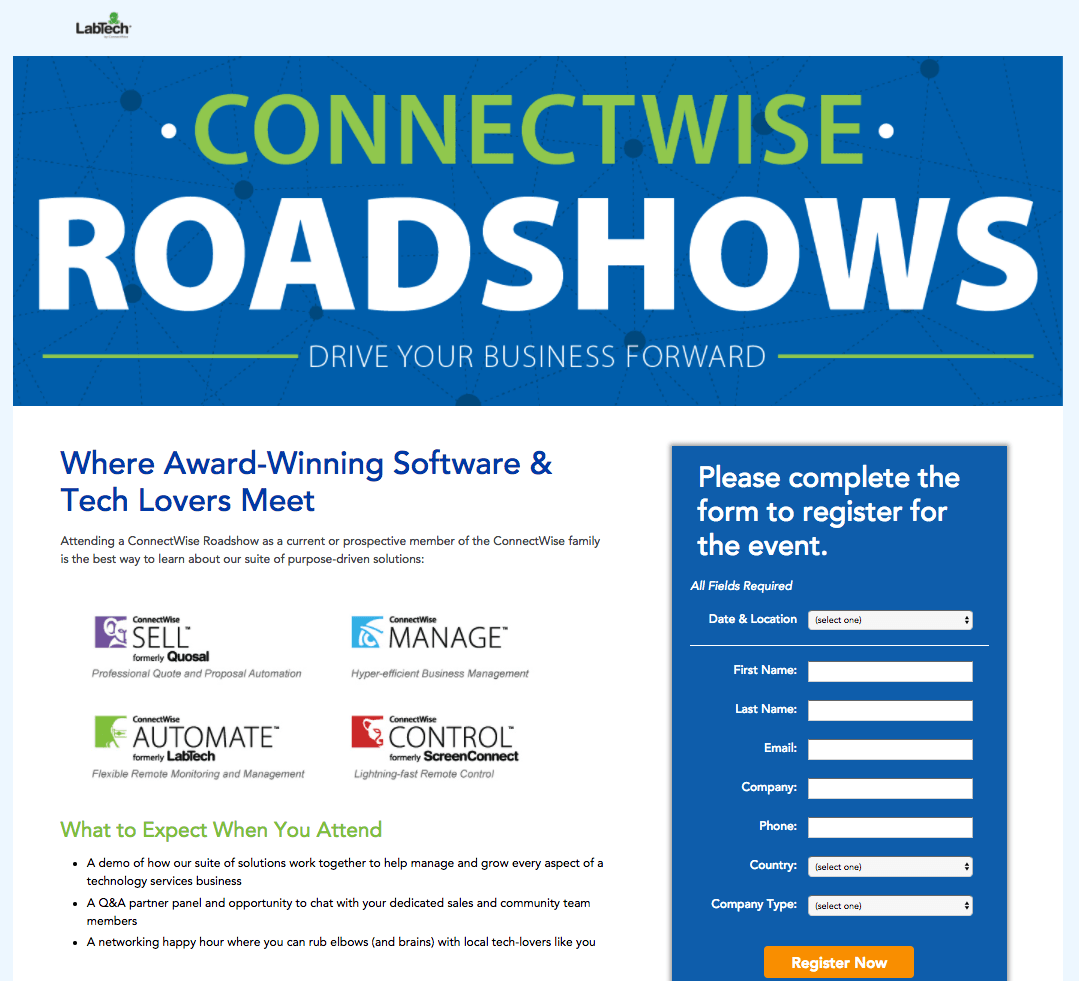
What they did well:
What to A/B test:
74. DigitalMarketer

What they did well:
What to A/B test:
75. Inkling
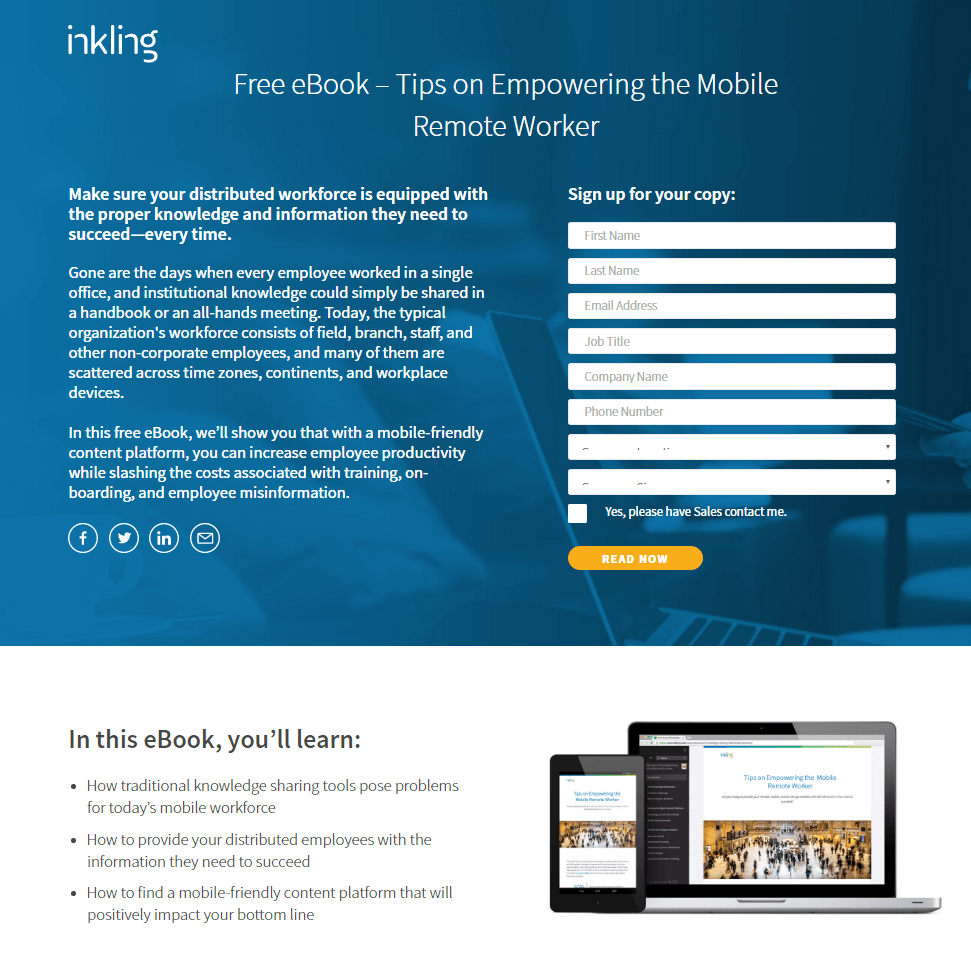
What they did well:
What to A/B test:
76. IMPACT

What they did well:
What to A/B test:
77. Nanigans
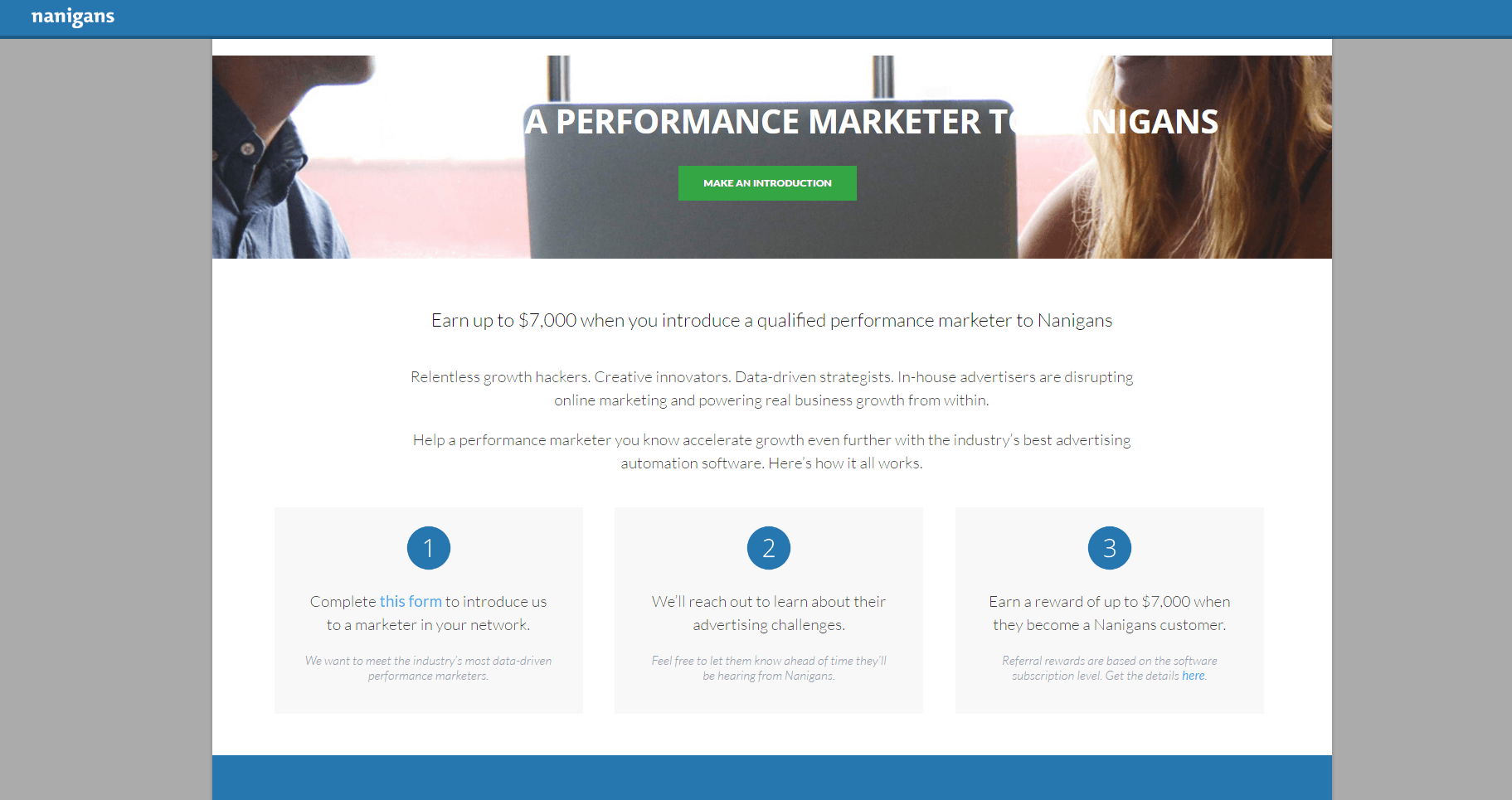
What they did well:
What to A/B test:
78. Simply Measured

What they did well:
What to A/B test:
79. Flywheel
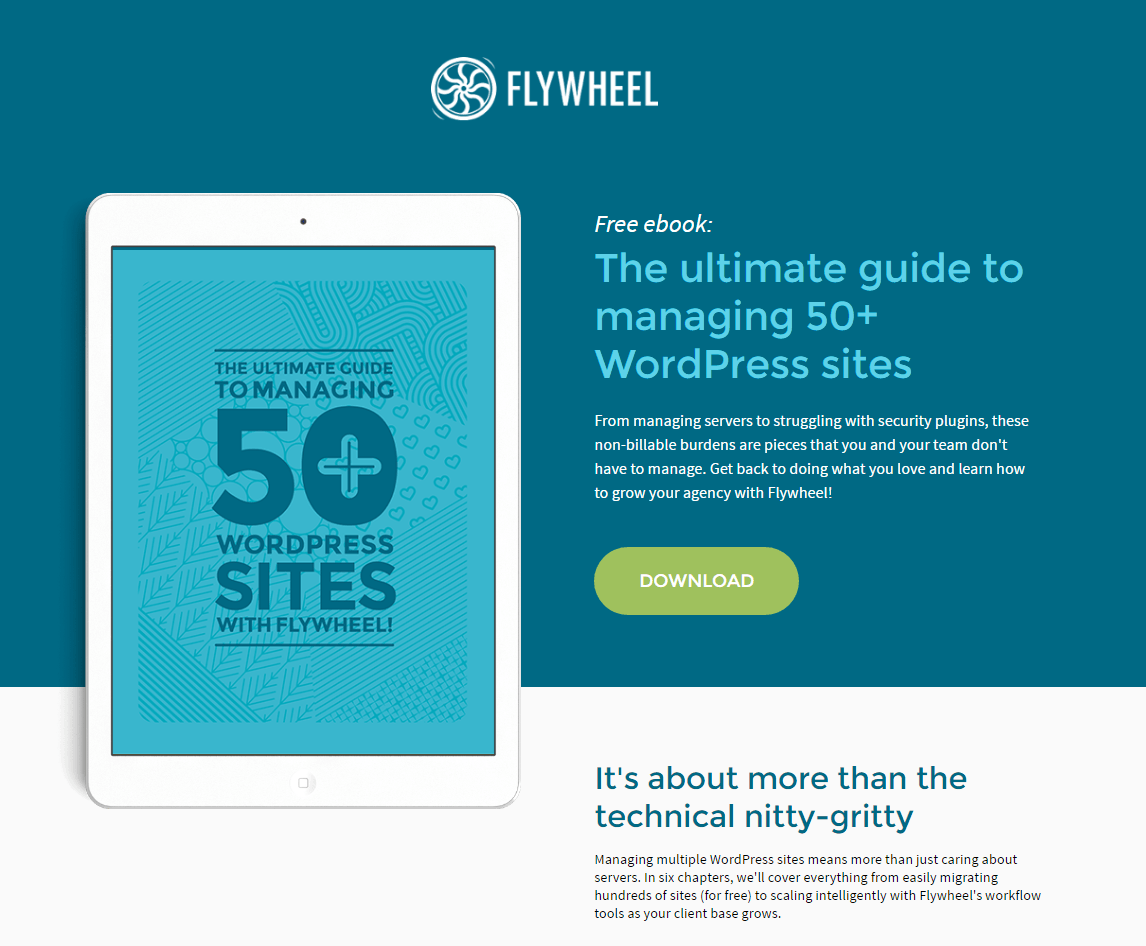
What they did well:
What could be AB tested:
80. Fitness Singles
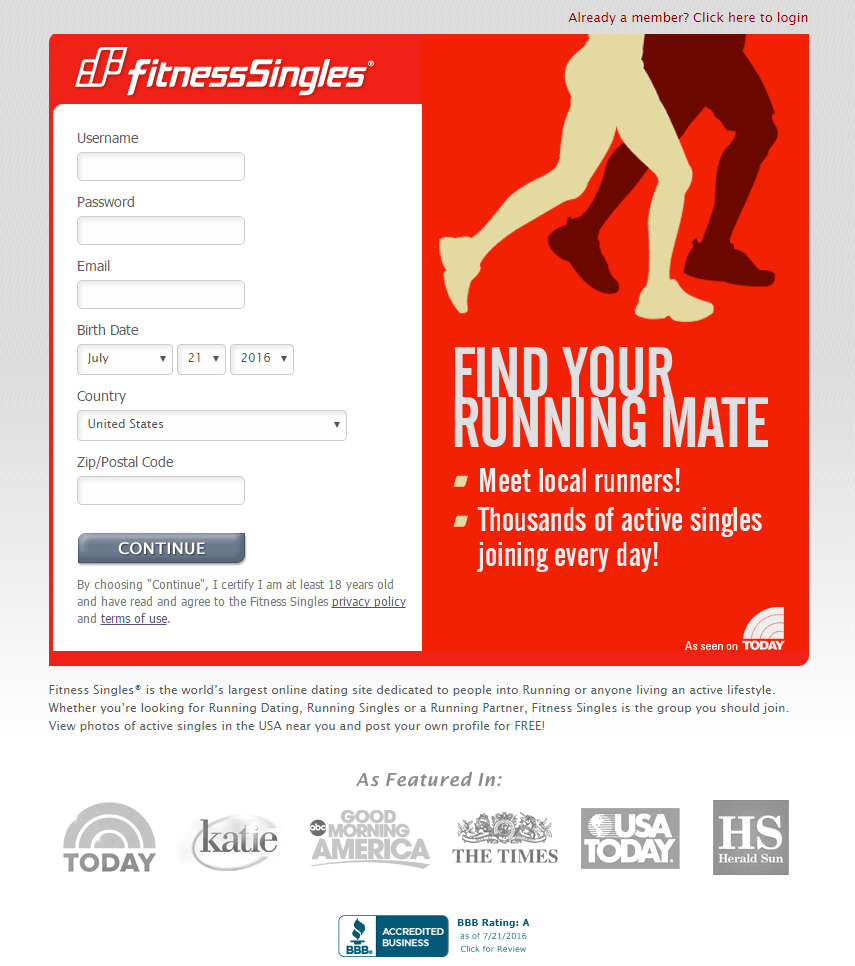
What they did well:
What to A/B test:
81. MasterClass
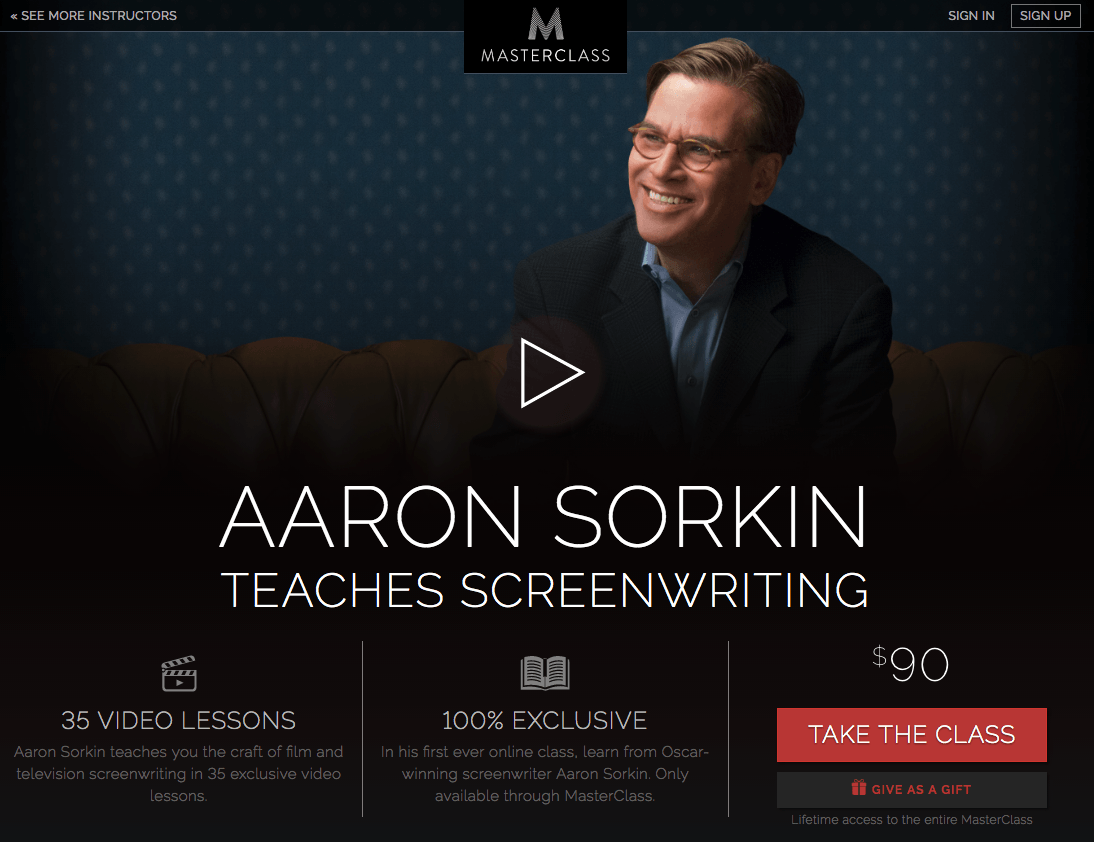
What they did well:
What to A/B test:
82. Tokyo Cheapo
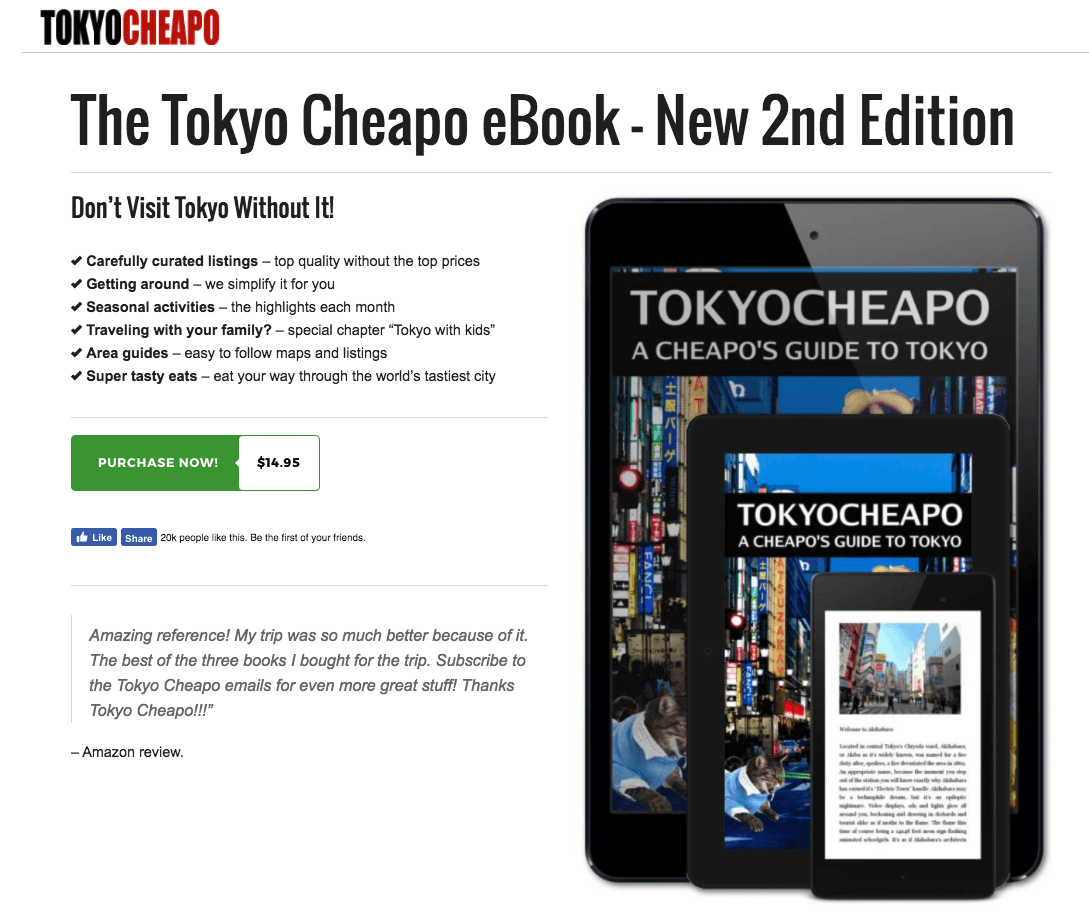
What they did well:
What to A/B test:
83. Salesforce
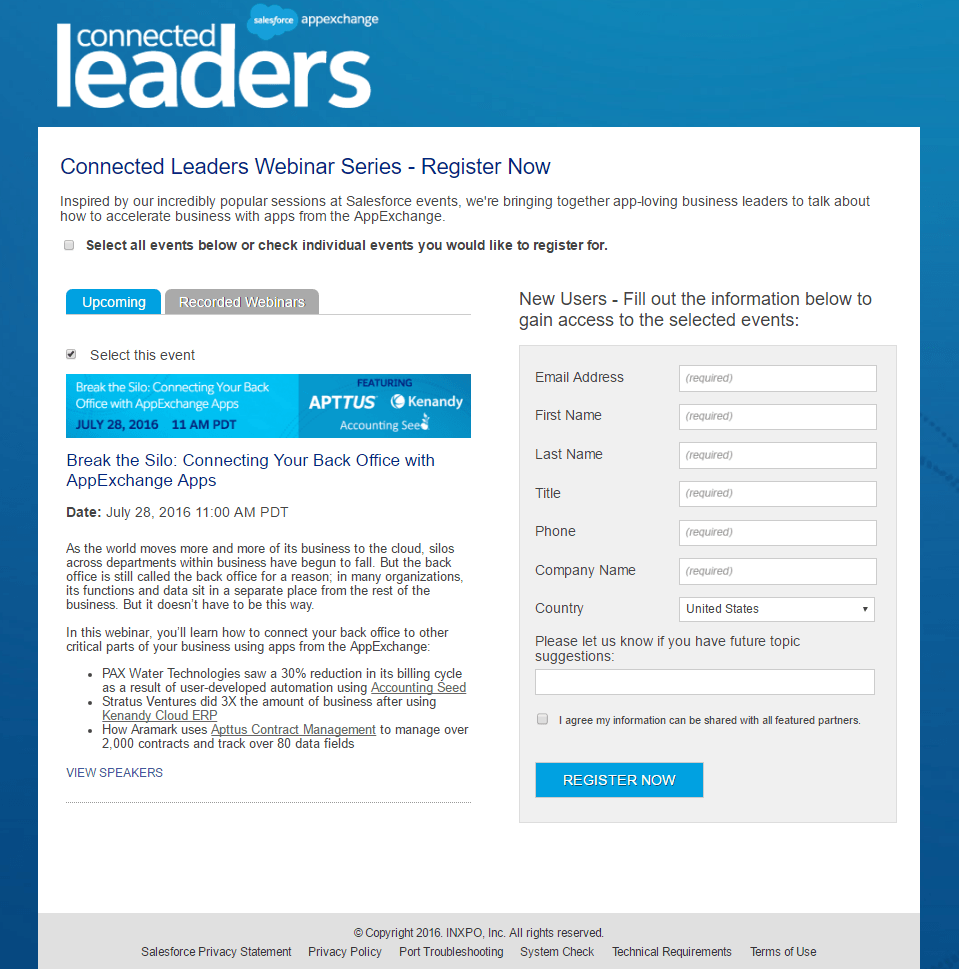
What they did well:
What to A/B test:
84. Zurple
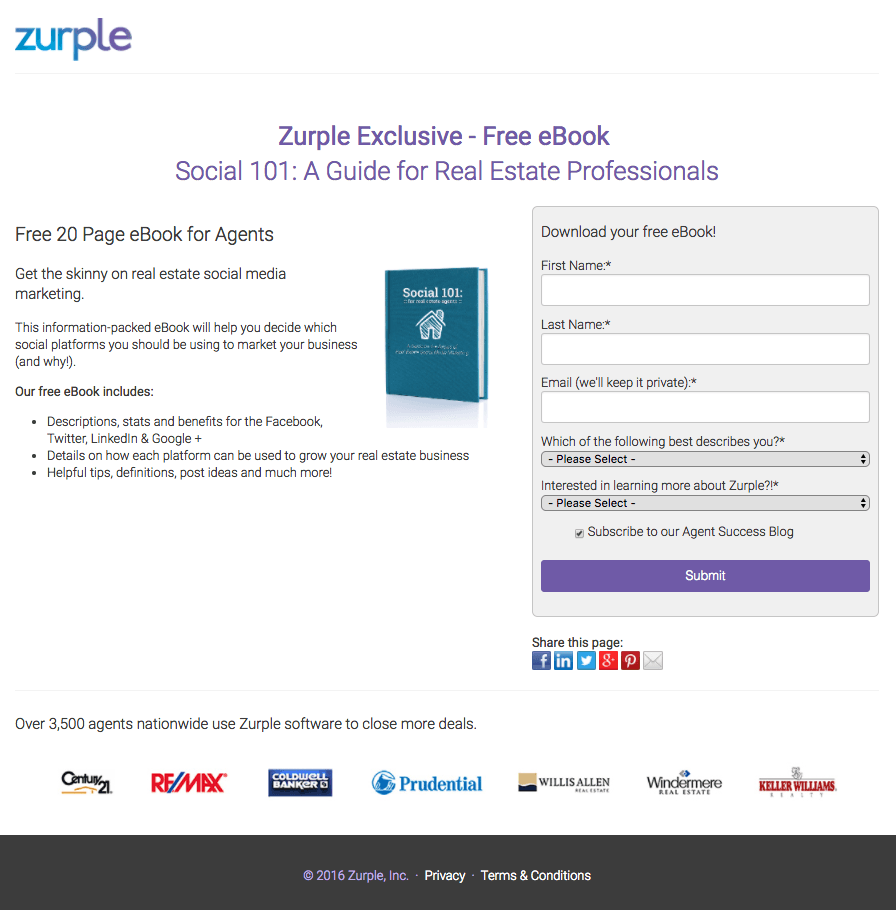
What they did well:
What could be improved:
85. Adaptiva

What they did well:
What to A/B test:
86. Serena

What they did well:
What to A/B test:
87. Propel Marketing

What they did well:
What to A/B test:
88. Outskirts Press

What they did well:
What to A/B test:
89. GKIC
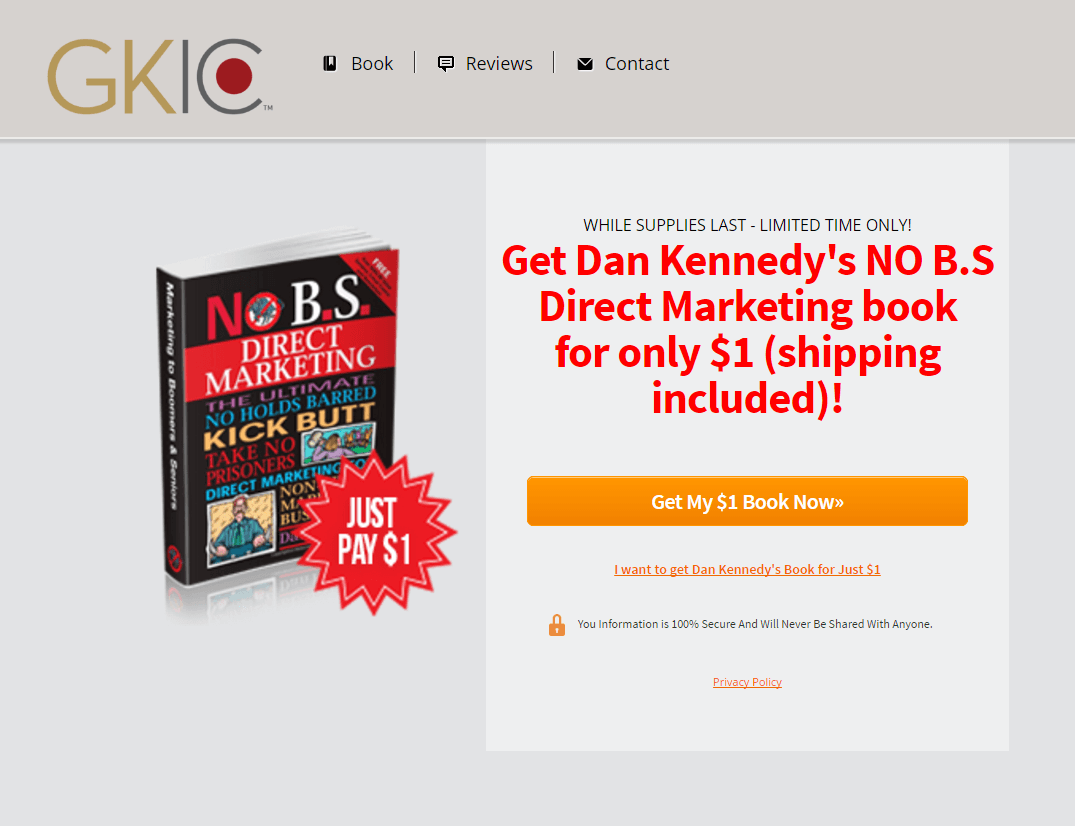
What they did well:
What to A/B test:
90. GrowthLab

What they did well:
What to A/B test:
91. ProBlogger

What they did well:
What to A/B test:
92. KlientBoost

What they did well:
What to A/B test:
93. Angel Therapy and Hay House University
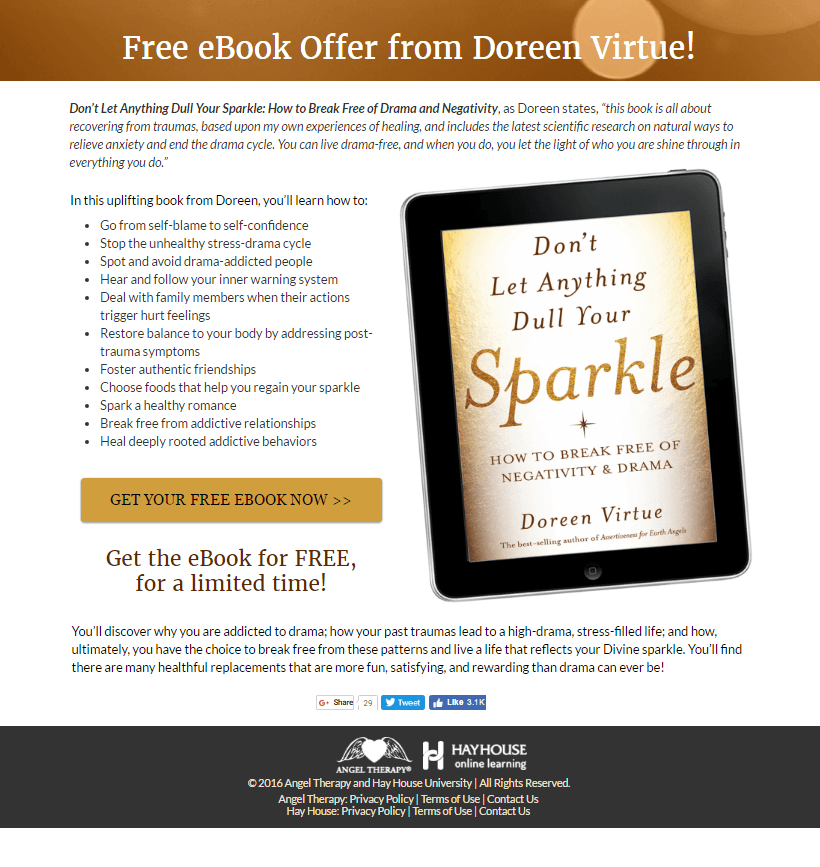
What they did well:
What to A/B test:
94. Skilljar

What they did well:
What to A/B test:
95. Jason Swenk
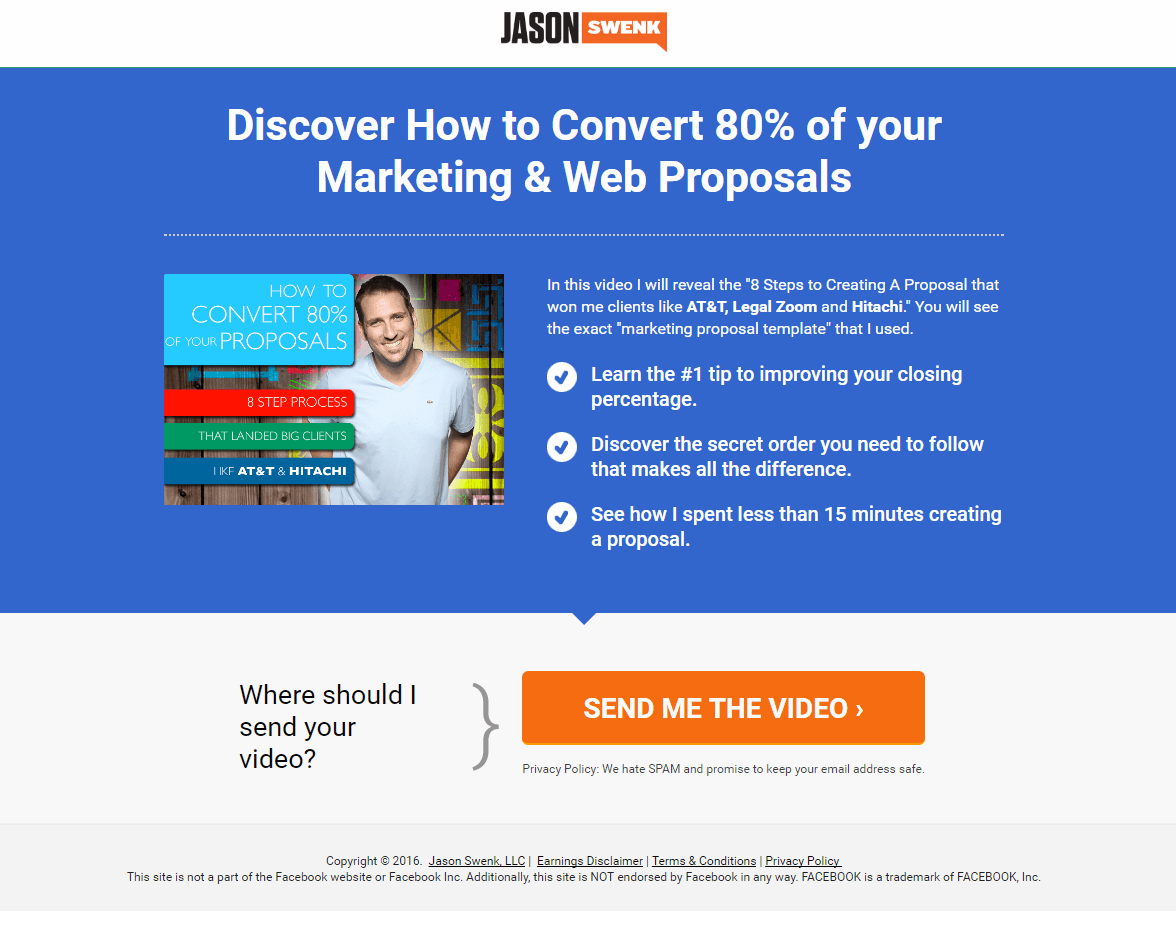
What they did well:
What to A/B test:
96. 180fusion
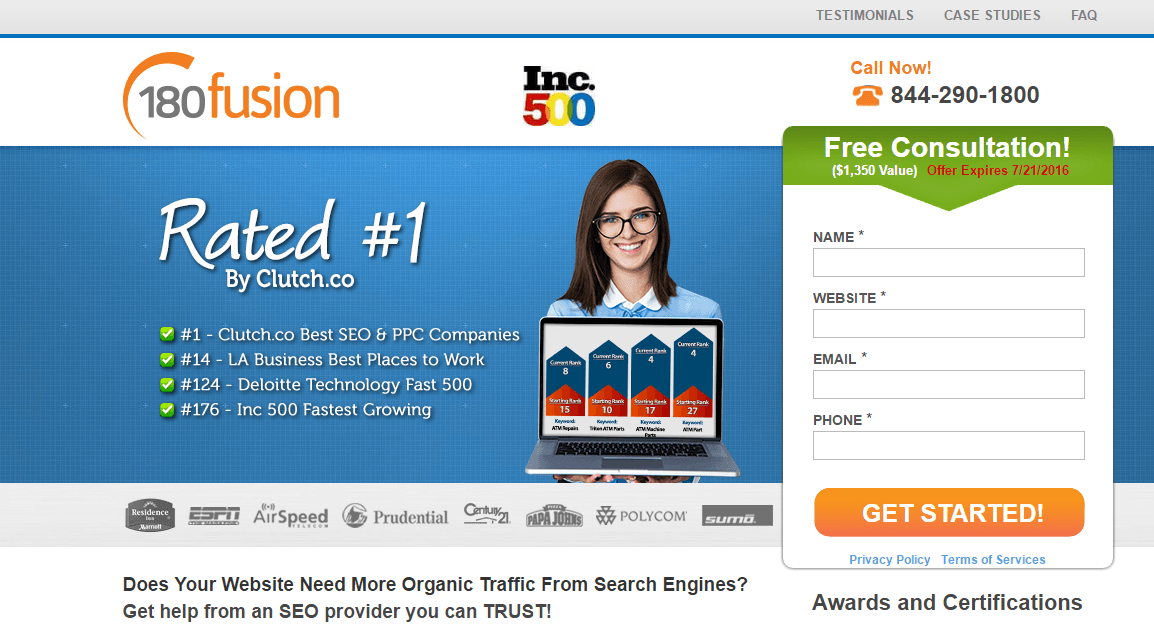
What they did well:
What to A/B test:
97. Linkfluencer

What they did well:
What to A/B test:
98. Kashurba Web Design

What they did well:
What to A/B test:
99. Fletcher Method
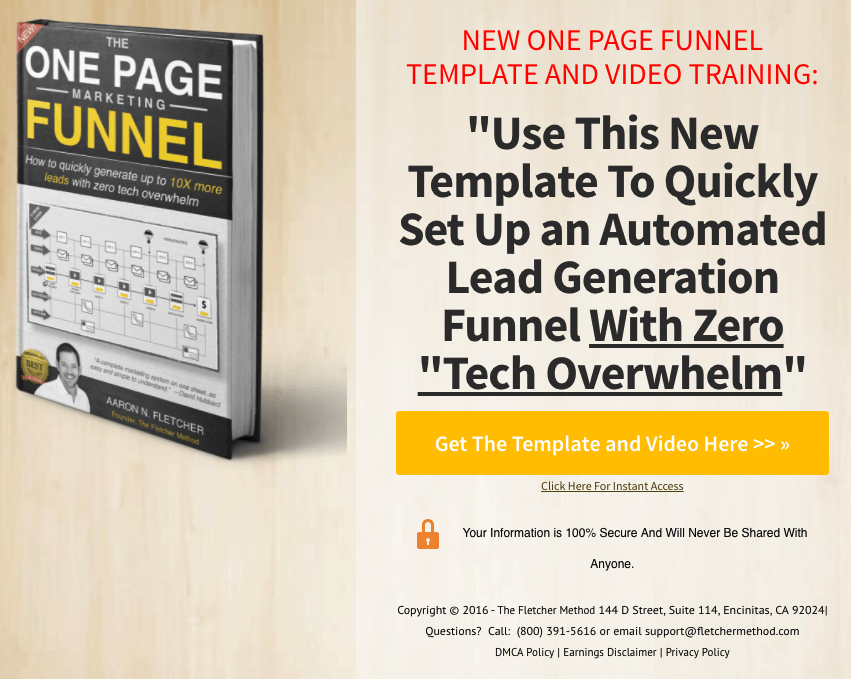
What they did well:
What to A/B test:
100. Simply Measured

What they did well:
What to A/B test:
101. LinkedSelling

What they did well:
What to A/B test:
102. Datorama

What they did well:
What to A/B test:
103. Sam Ovens

What they did well:
What to A/B test:
104. Lurn

What they did well:
What to A/B test:
105. Online Marketing Classroom
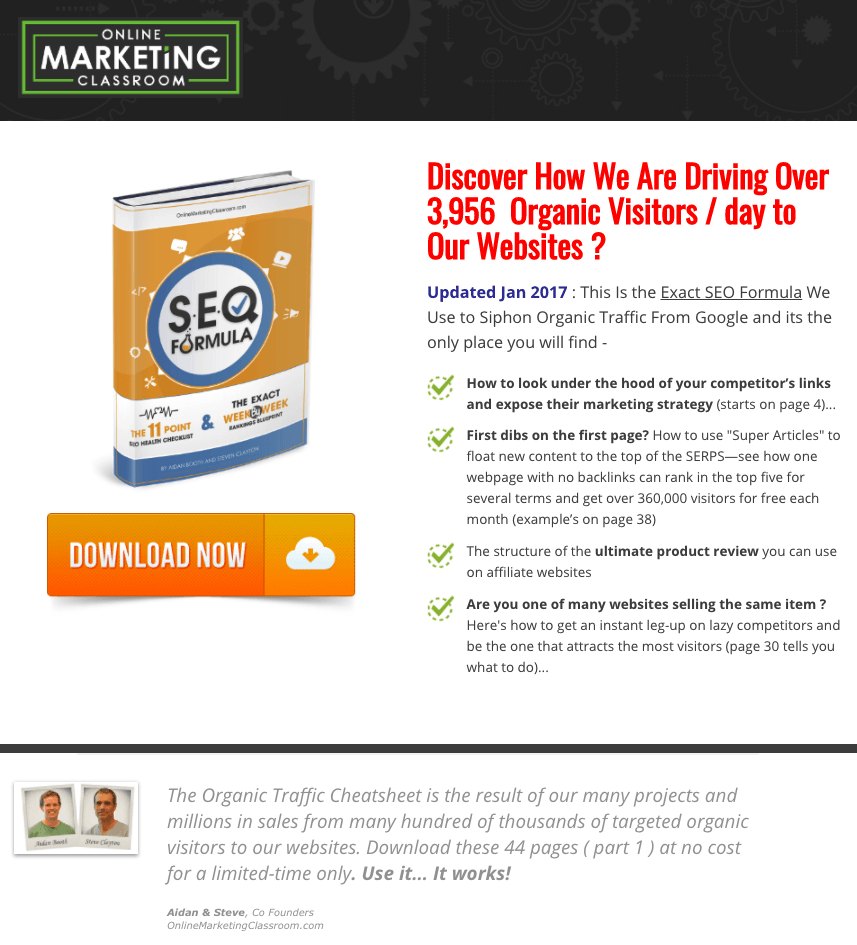
What they did well:
What to A/B test:
106. More Clients More Results
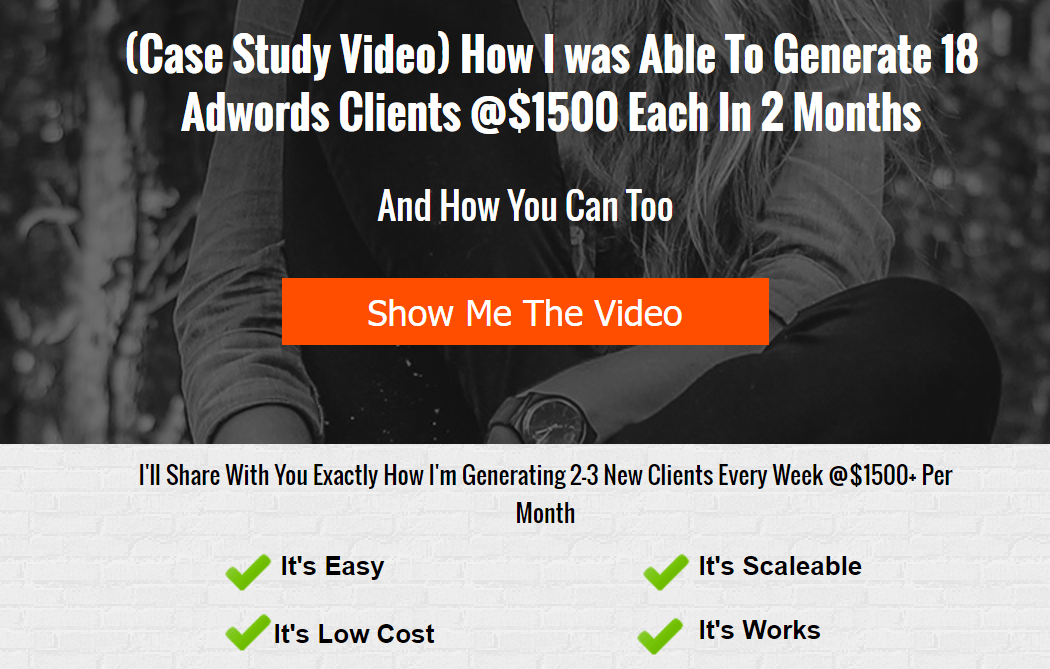
What they did well:
What to A/B test:
107. Pepperdata

What they did well:
What to A/B test:
108. The Law of Attraction World

What they did well:
What to A/B test:
109. Coaching Soccer Tactics

What they did well:
What to A/B test:
110. Midas Media
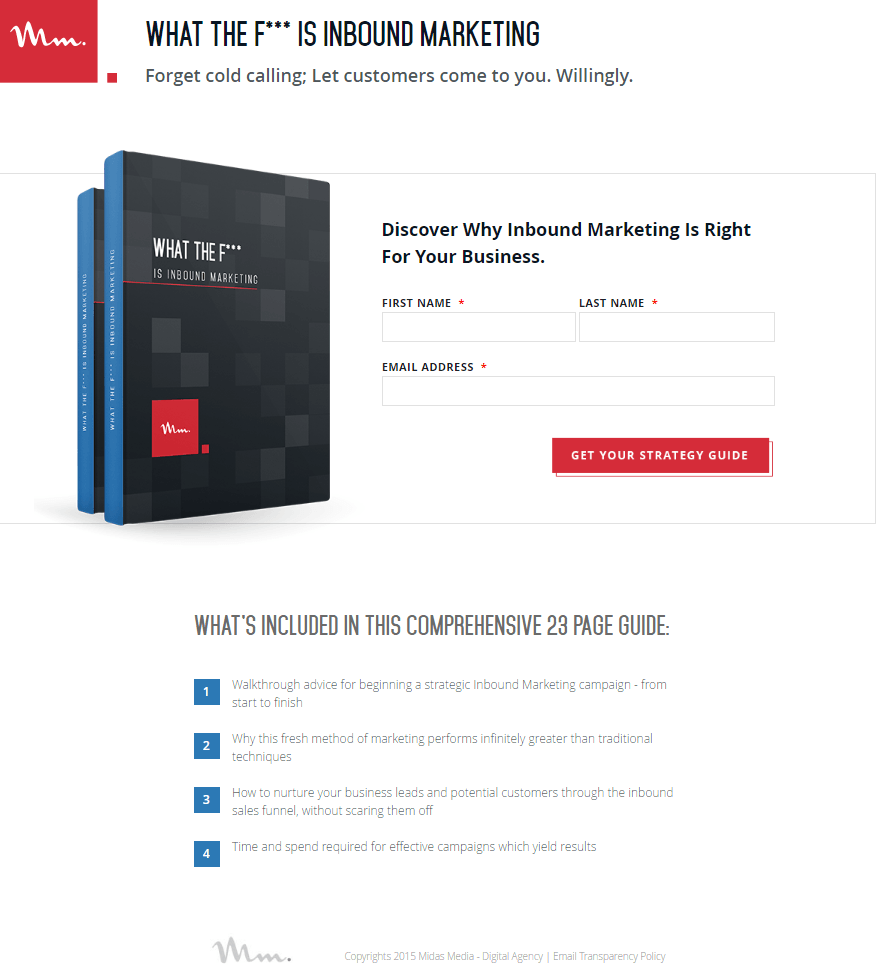
What they did well:
What to A/B test:
111. Infusionsoft

What they did well:
What to A/B test:
112. Membership Site Masters
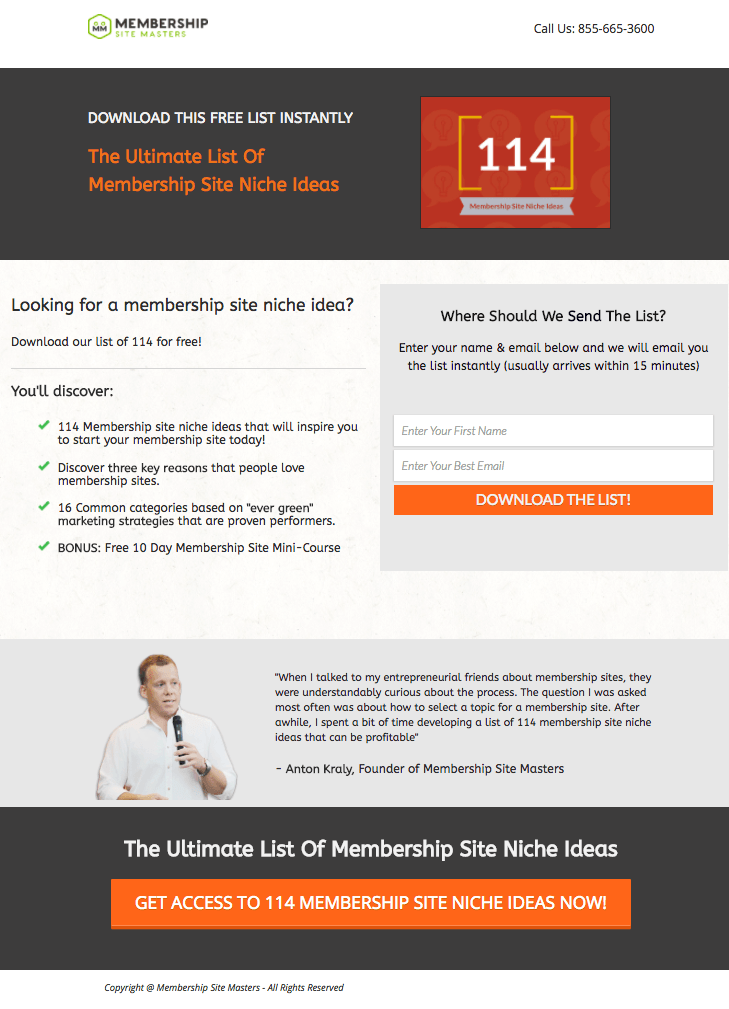
What they did well:
What to A/B test:
113. Social Scaling Formula

What they did well:
What to A/B test:
114. StubGroup

What they did well:
What to A/B test:
115. Reset Warrior

What to A/B test:
How do your landing page examples measure up?
Did you make any of the mistakes the brands above did? How do your landing page examples look in comparison? Need ideas on how to write your own copy or looking to create optimized landing pages using conversion-focused templates without a developer? Try Instapage - sign up for a 14-day free trial.

Try the world's most advanced landing page platform with a risk-free trial.
